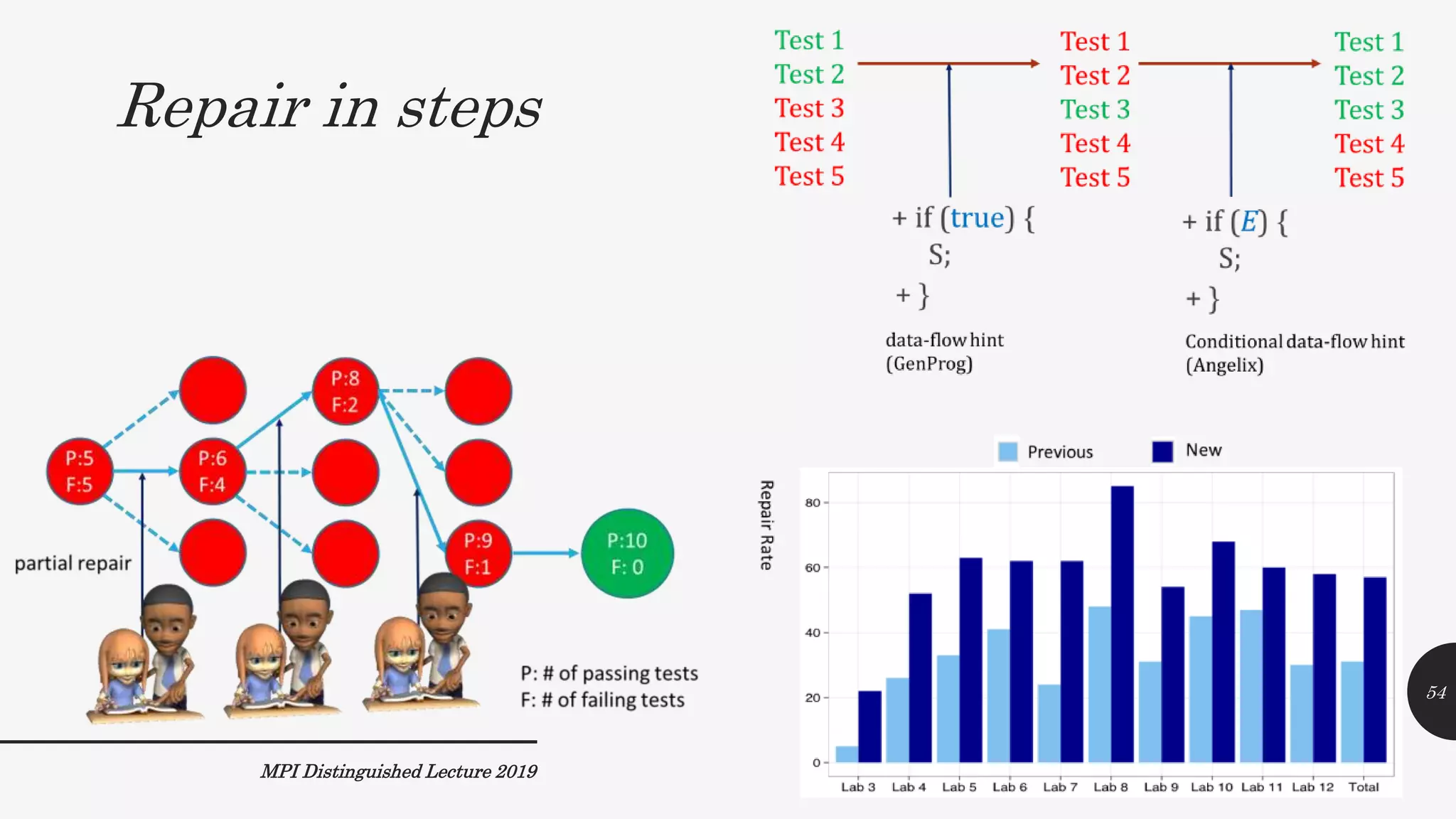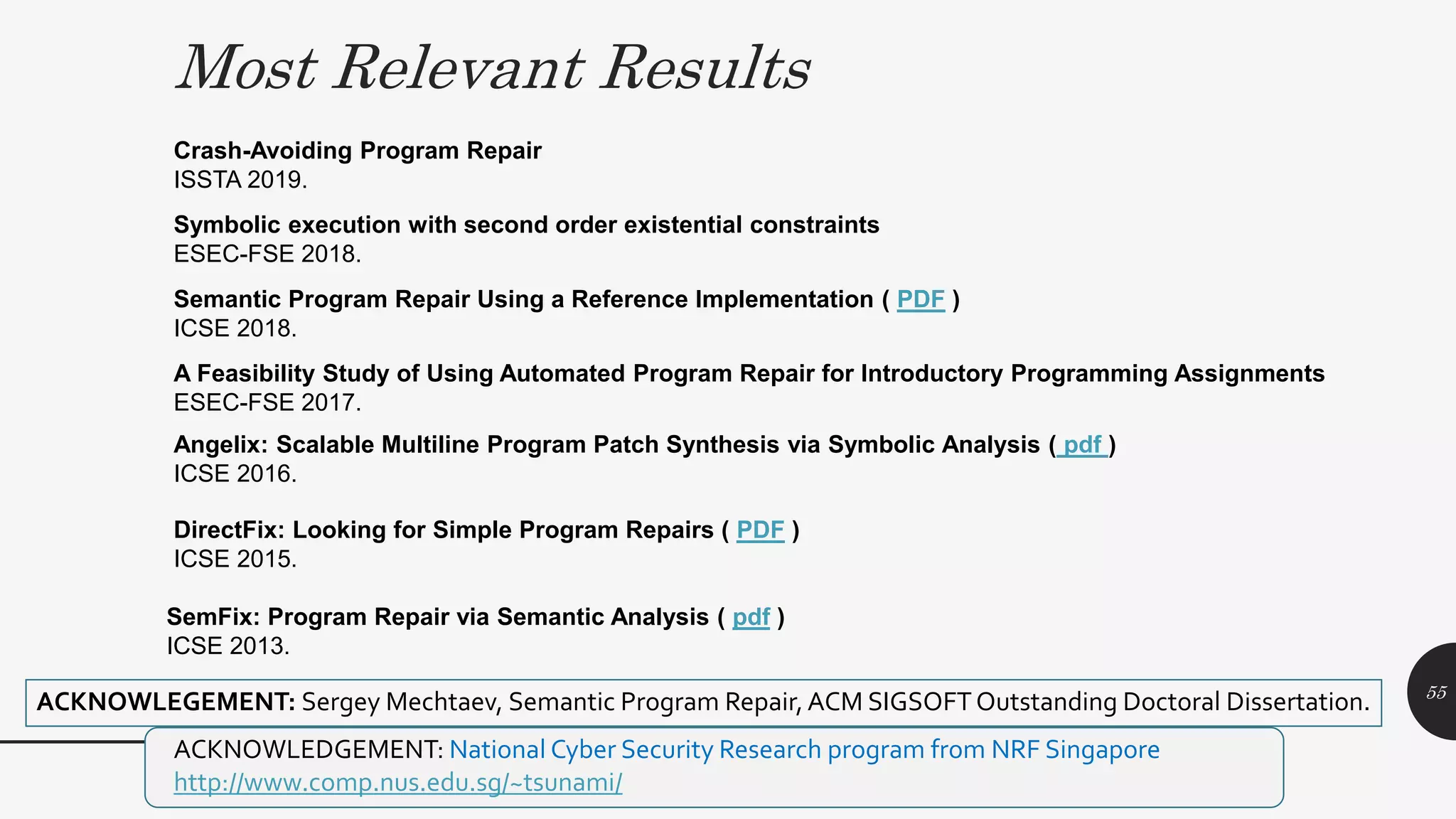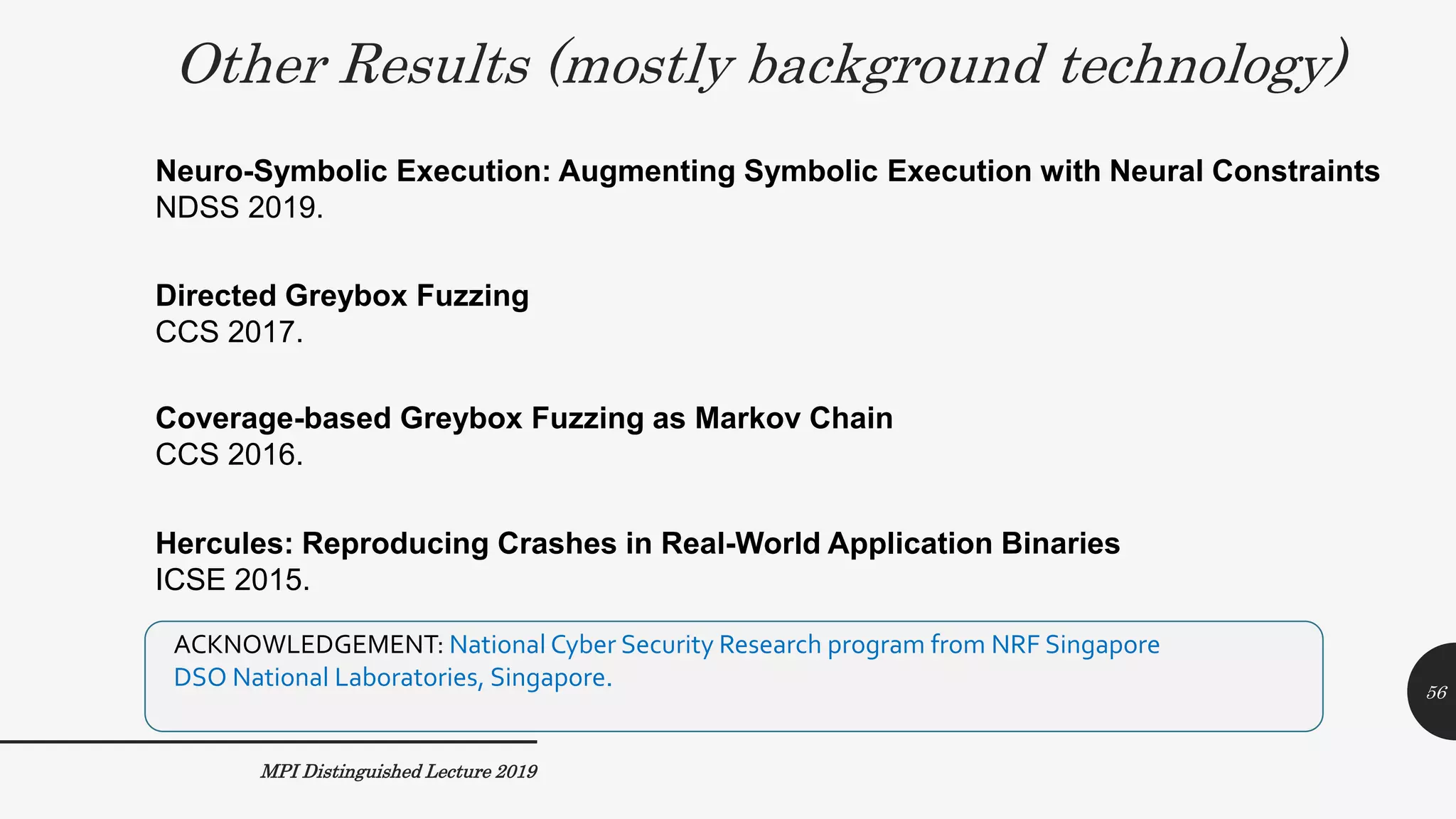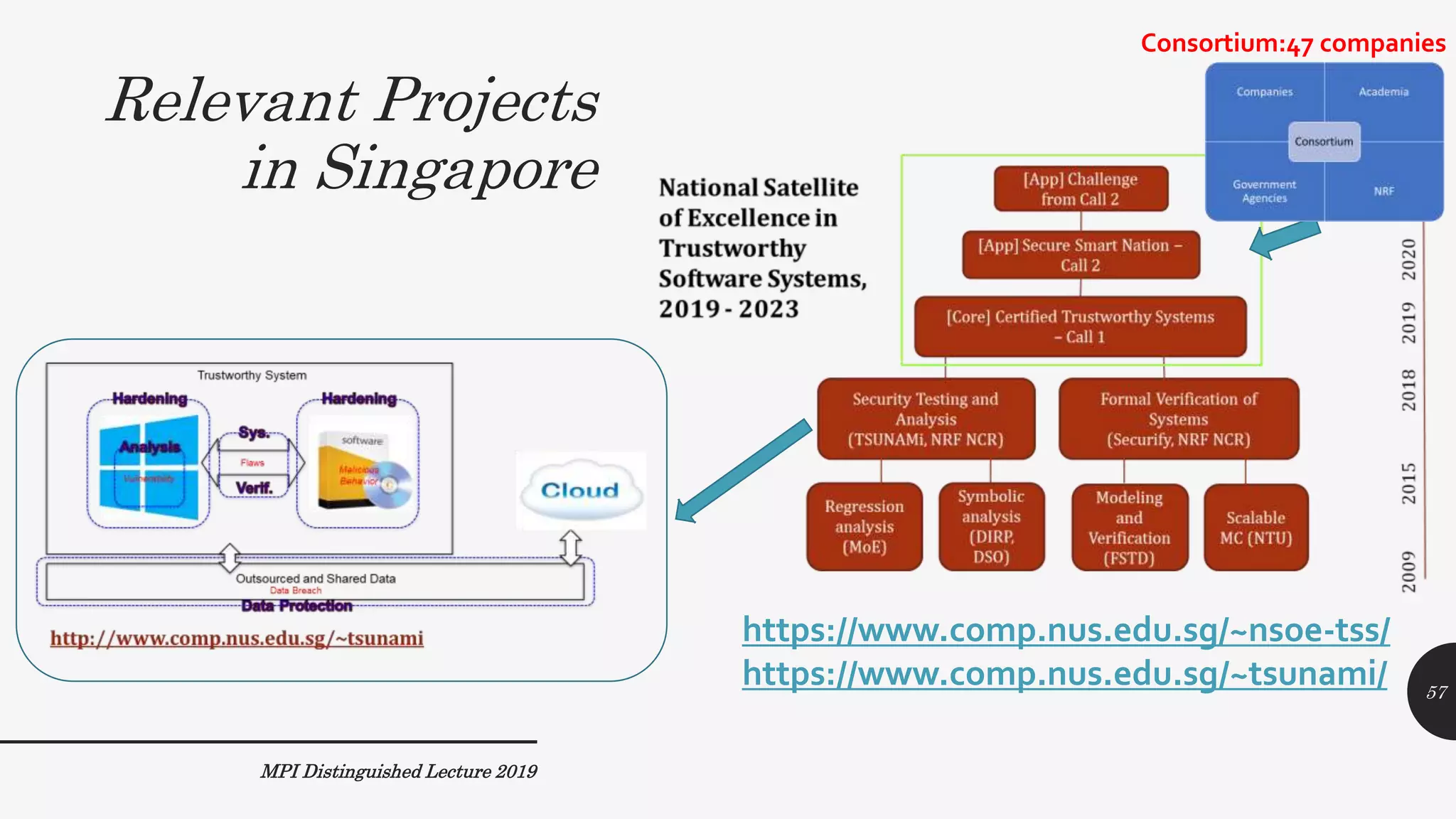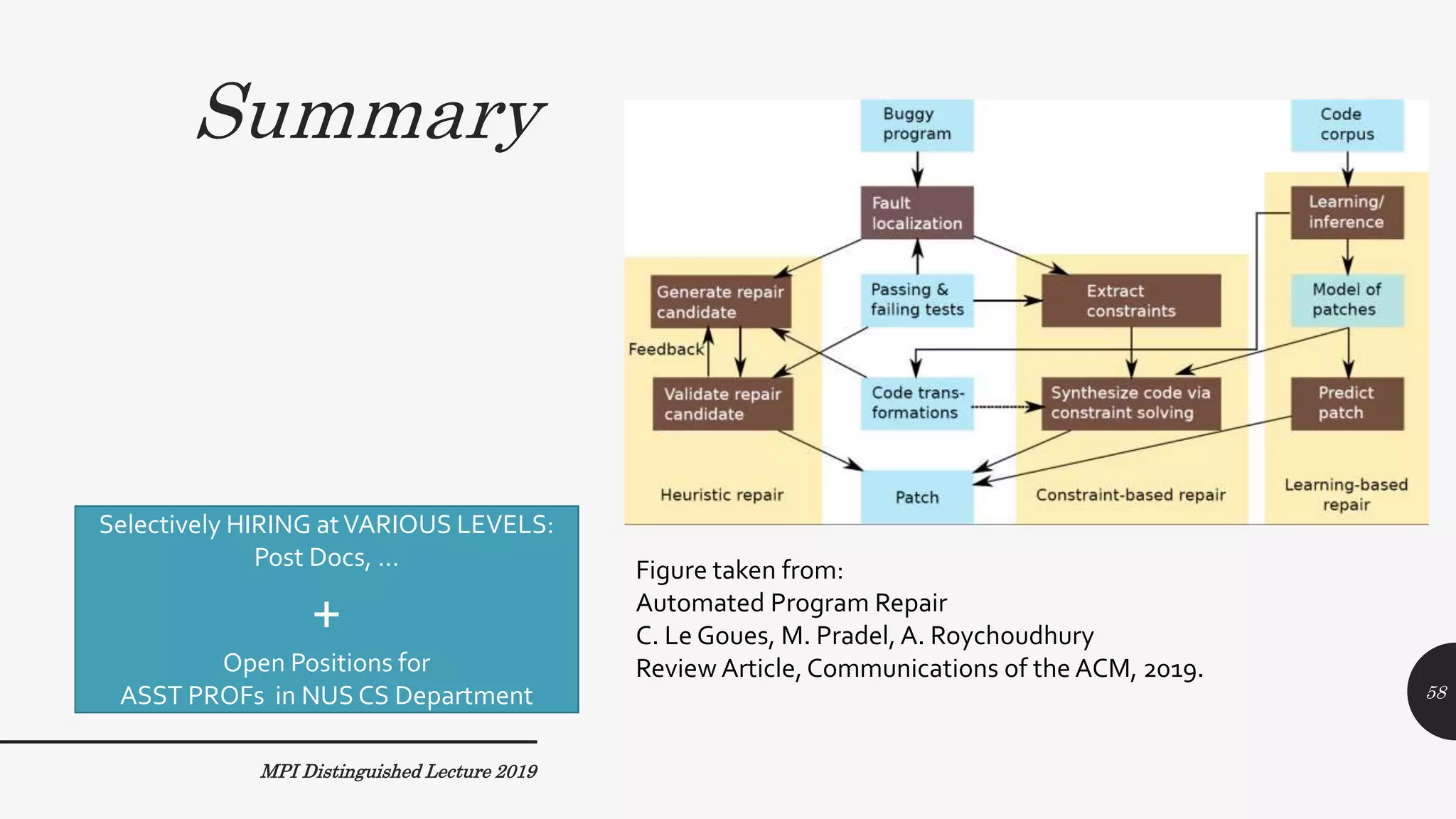The lecture by Professor Abhik Roychoudhury at the MPI Distinguished Lecture 2019 discusses the challenges in program analysis, focusing on software error detection and automated program repair. It emphasizes the importance of symbolic execution and fuzzing techniques for detecting and repairing software defects, advocating for a systematic approach to program repair rather than reliance on random techniques. Furthermore, the talk explores the concept of specification inference and self-healing in programs when formal specifications are not available.
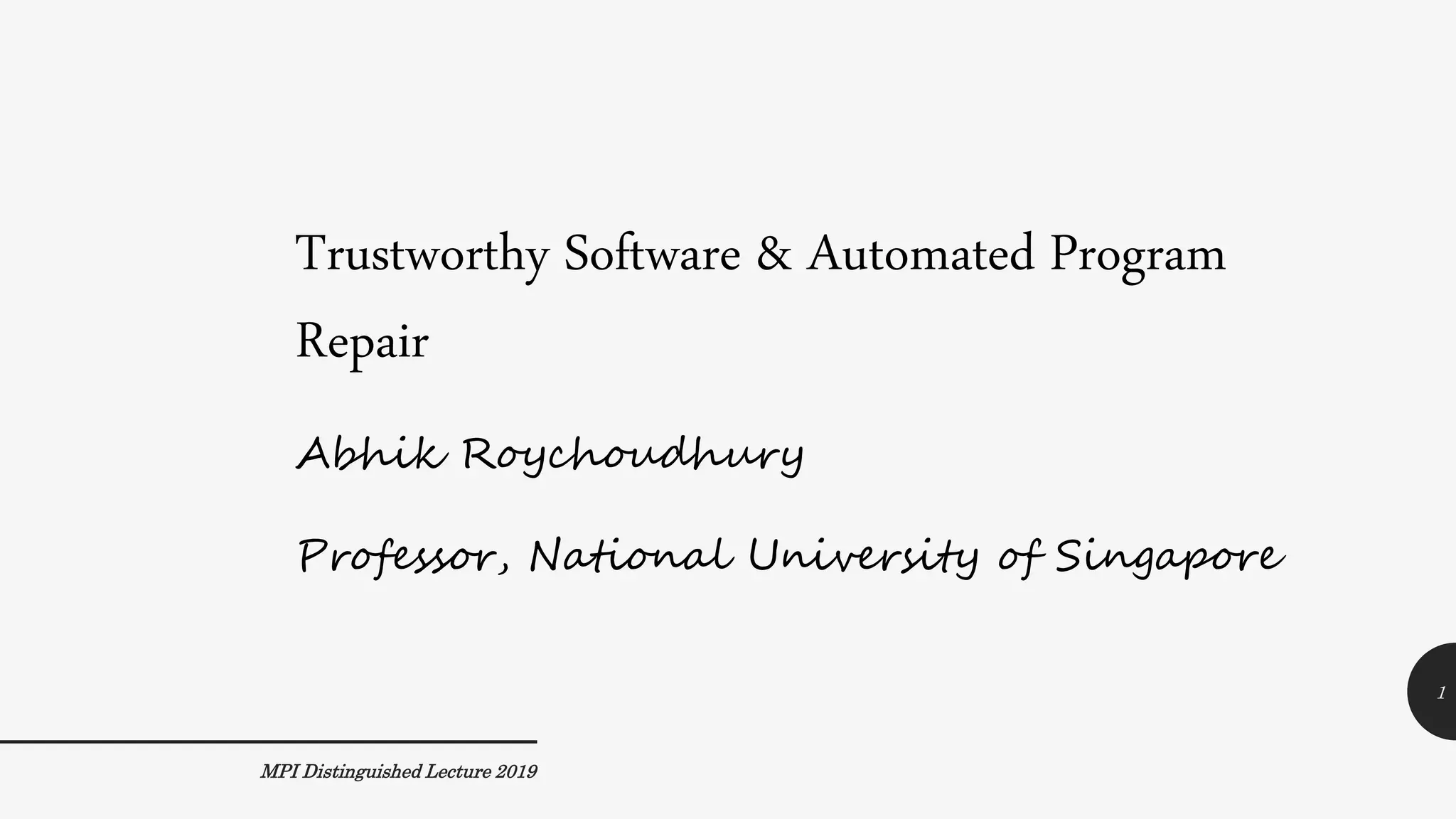
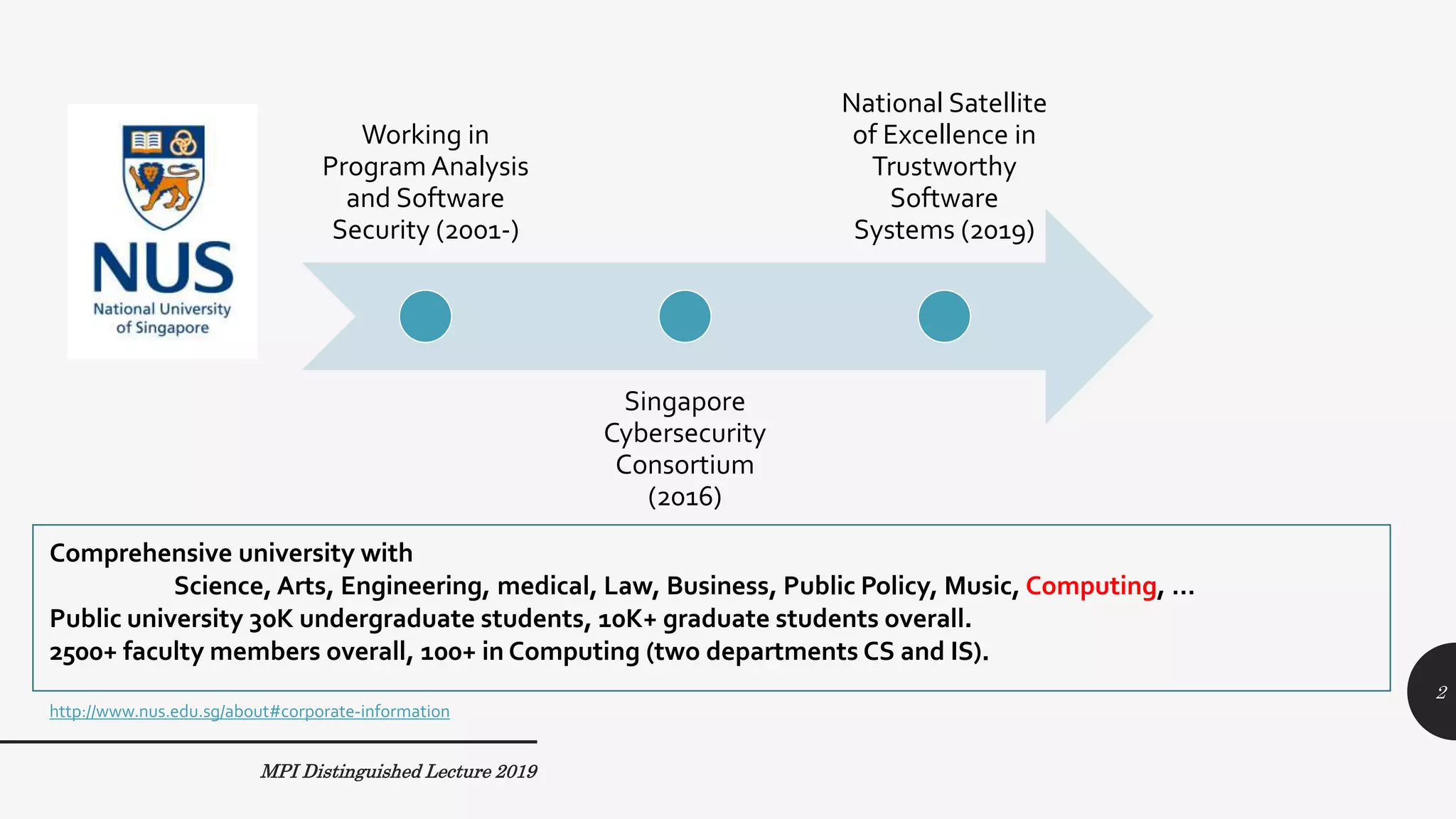
![Snapshot of
the talk
• Search problems in software error detection.
• Fuzzing and Symbolic Execution : Random search and
logical analysis.
• Random Search techniques are becoming more effective.
• [PRELUDE]
• The problem of program repair, as opposed to error
detection.
• Symbolic technique produces higher quality patches
than random or biased random search.
• Novel view of symbolic execution for spec. inference.
• [MAIN PART of theTALK]
MPI Distinguished Lecture 2019
3](https://image.slidesharecdn.com/mpi2019-190712015333/75/Automated-Program-Repair-Distinguished-lecture-at-MPI-SWS-3-2048.jpg)
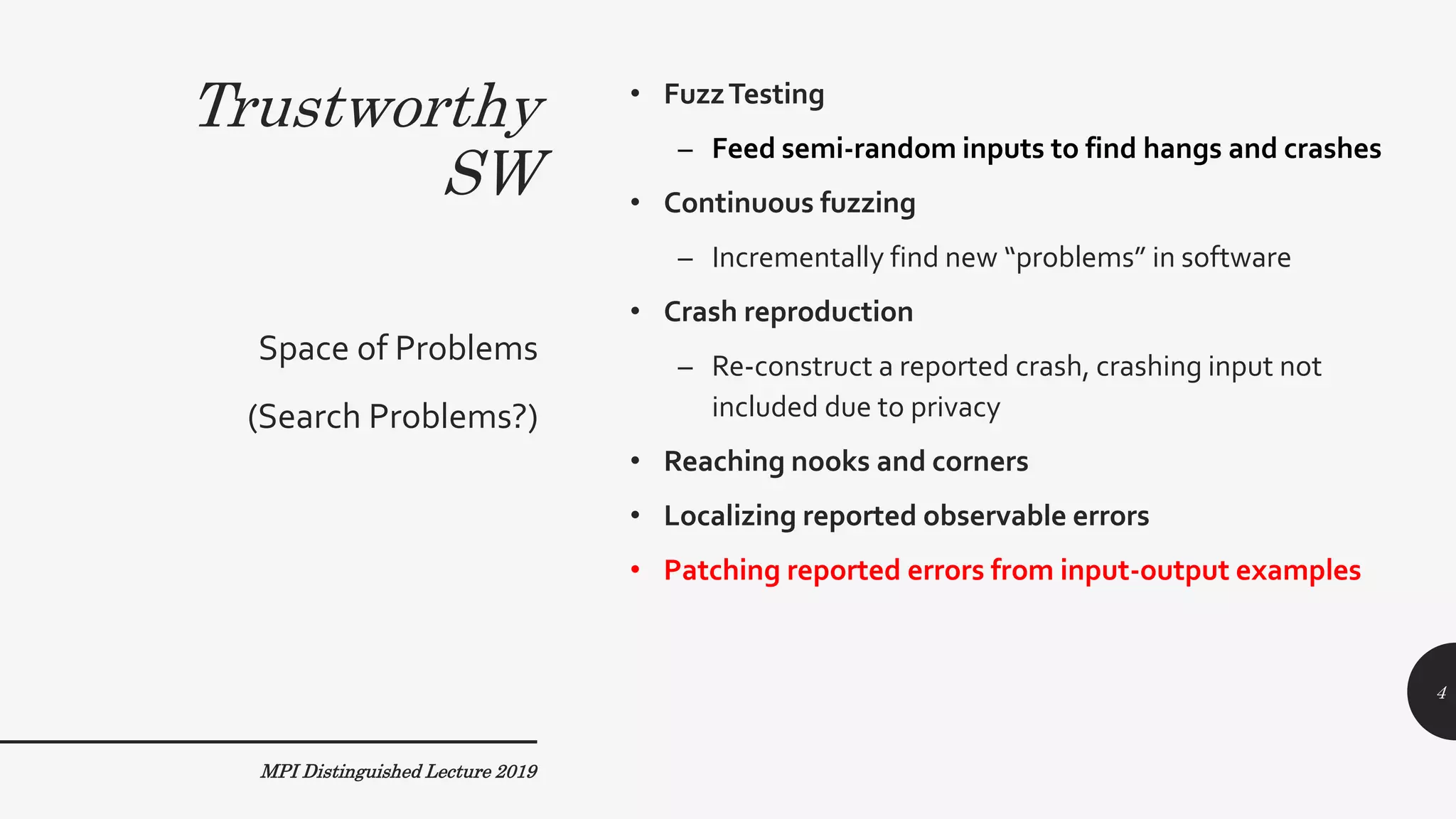
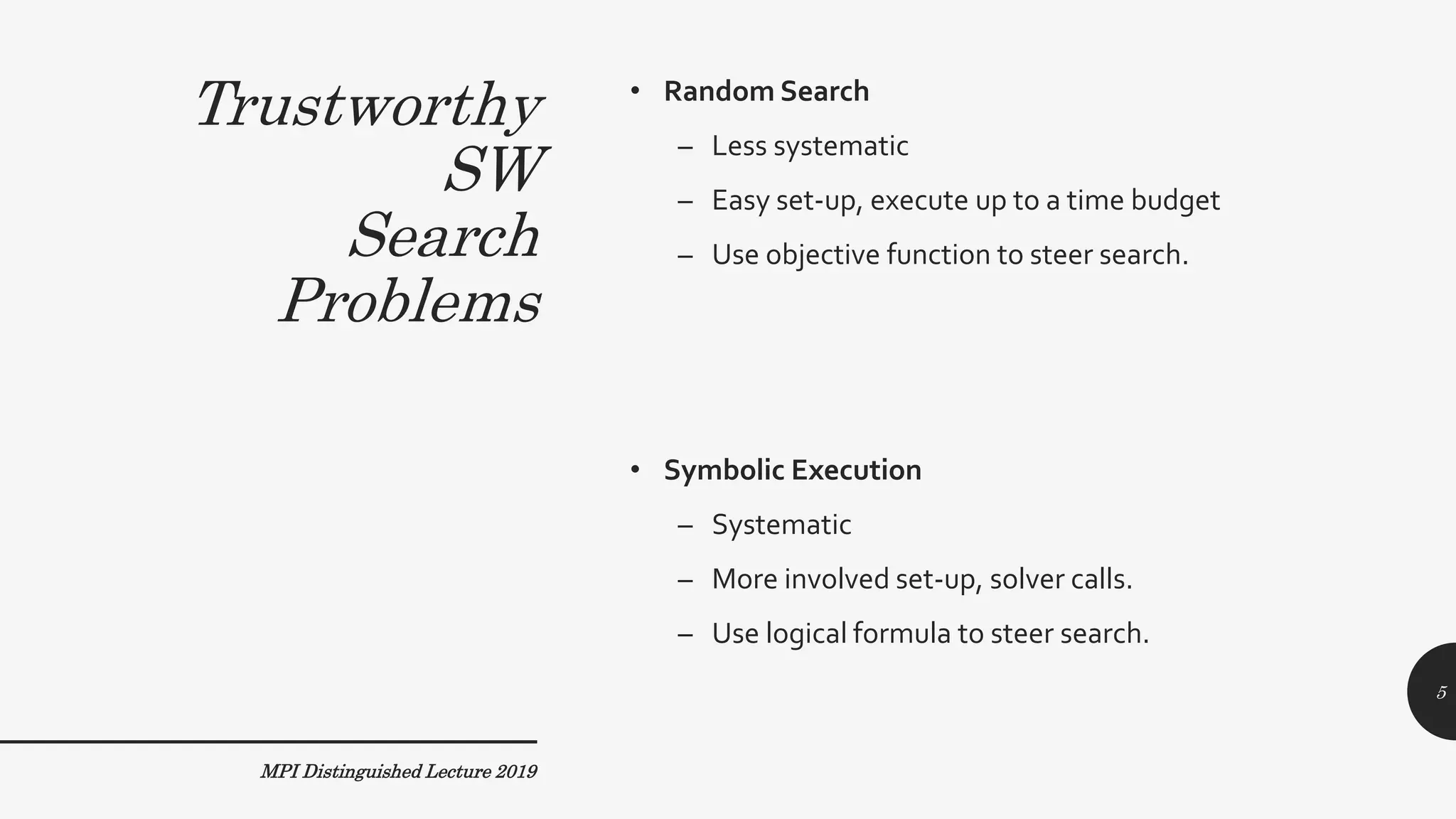
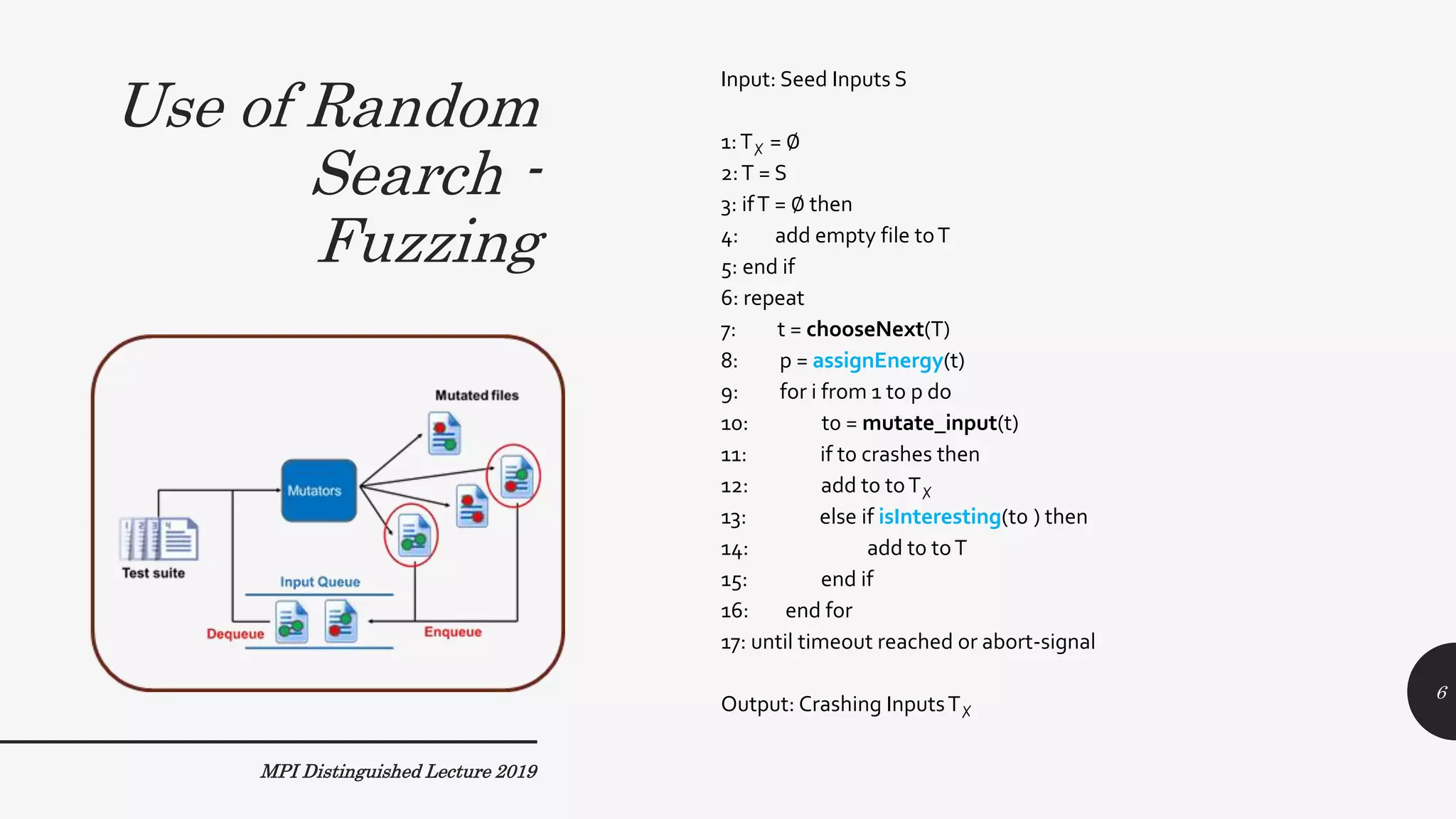
![Intuition
• if (condition1)
• return // short path, frequented by many many
inputs
• else if (condition2)
• exit // short paths, frequented by many inputs
• else ….
MPI Distinguished Lecture 2019
[CCS16, and its adoption]
7](https://image.slidesharecdn.com/mpi2019-190712015333/75/Automated-Program-Repair-Distinguished-lecture-at-MPI-SWS-7-2048.jpg)
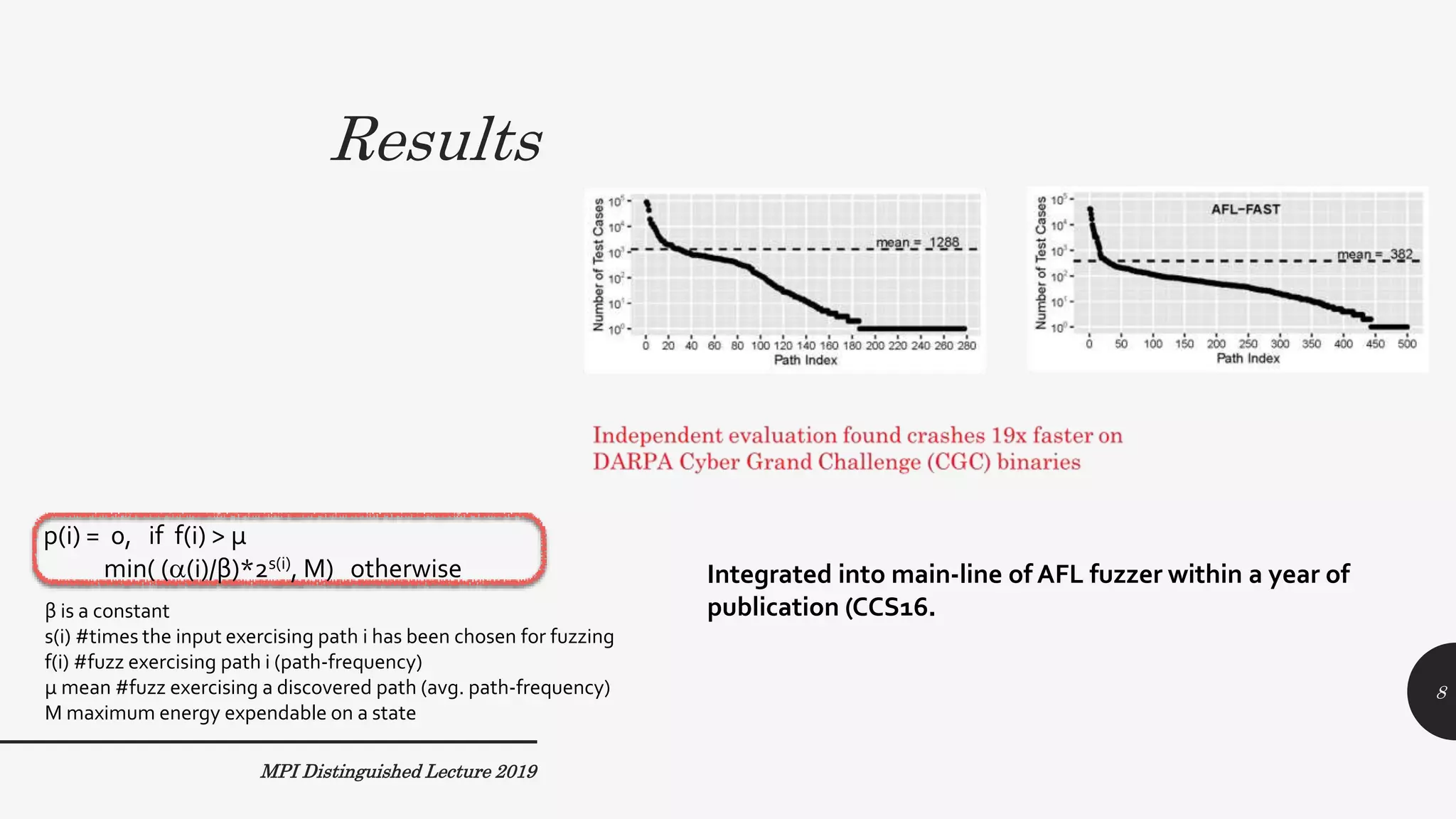
![MPI Distinguished Lecture 2019
SEARCH( A, L, U, X, found, j){
int j, found = 0;
while (L <= U && found == 0){
j = (L+U)/2;
if (X == A[j]){ found = 1;}
else if (X < A[j]){ U = j -1; }
else{ L = j +1; }
}
if (found == 0){ j = L – 1;}
}
SEARCH(A, 1, 5, 20, found, j)
SEARCH(A, 1, 5, X, found, j)
SEARCH(A, N, N+4, X, found, j)
SEARCH(A, 1, M, X, found, j)
Testing ?
Comprehension??
Verification ???
Blurring the lines
“Program testing and
program proving can be
considered as extreme
alternatives. ….
This paper describes a
practical approach between
these two extremes …
Each symbolic execution
result may be equivalent to a
large number of normal tests”
9](https://image.slidesharecdn.com/mpi2019-190712015333/75/Automated-Program-Repair-Distinguished-lecture-at-MPI-SWS-9-2048.jpg)
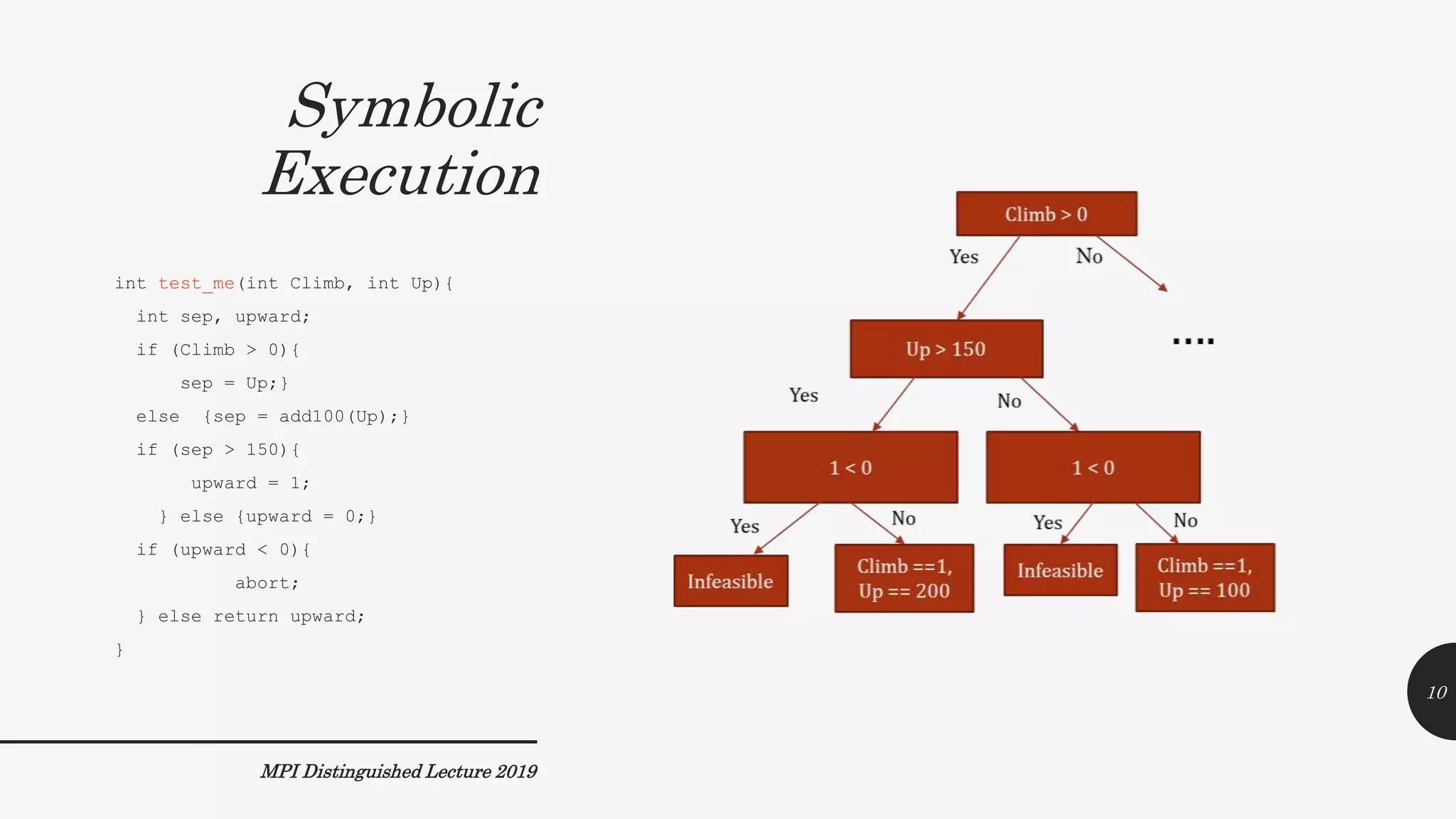
![Symbolic Execution
MPI Distinguished Lecture 2019
int test_me(int Climb, int
Up){
int sep, upward;
if (Climb > 0){
sep = Up;}
else {sep = add100(Up);}
if (sep > 150){
upward = 1;
} else {upward = 0;}
if (upward < 0){
abort;
} else return upward;
}
11
Execute IF(r) : FORK
[provided r is unresolved]
Then: PC := PC r
Else: PC := PC r
Execute IF(r)
Resolved branch condition r
using concrete values
Suppose true, PC := PC r , OR
Suppose false, PC := PC r](https://image.slidesharecdn.com/mpi2019-190712015333/75/Automated-Program-Repair-Distinguished-lecture-at-MPI-SWS-11-2048.jpg)
![Fuzzing vs. Symbolic Execution
Bug Finding
- Symbolic execution tree construction e.g. KLEE
[Modeling system environment]
- Grey-box fuzz testing for systematic path exploration
inspired by concolic execution
AFLFast
MPI Distinguished Lecture 2019
12](https://image.slidesharecdn.com/mpi2019-190712015333/75/Automated-Program-Repair-Distinguished-lecture-at-MPI-SWS-12-2048.jpg)
![Fuzzing vs. Symbolic Execution
ReachabilityAnalysis
Reachability of a location in the program
- Traverse the symbolic execution tree using search
strategies e.g. Hercules
- Encode it as an optimization
problem inside the genetic search
of grey-box fuzzing AFLGo
MPI Distinguished Lecture 2019
[CCS17]
13](https://image.slidesharecdn.com/mpi2019-190712015333/75/Automated-Program-Repair-Distinguished-lecture-at-MPI-SWS-13-2048.jpg)
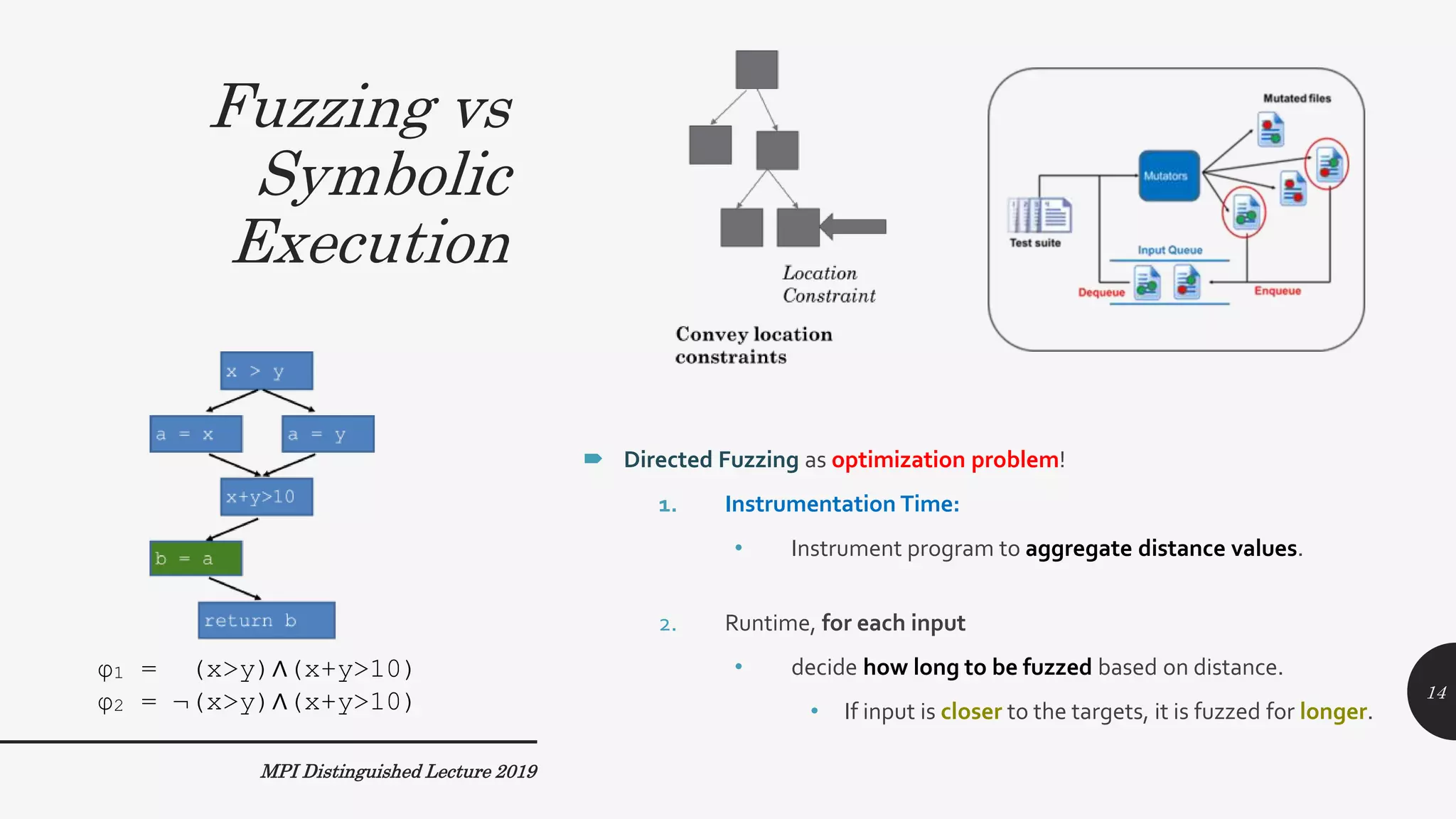
![Digression: Fuzzing
vs Symbolic
Execution
MPI Distinguished Lecture 2019
Neuro-symbolic execution
[NDSS19]
15
(Ack: figure from P Saxena and co-authors)](https://image.slidesharecdn.com/mpi2019-190712015333/75/Automated-Program-Repair-Distinguished-lecture-at-MPI-SWS-15-2048.jpg)
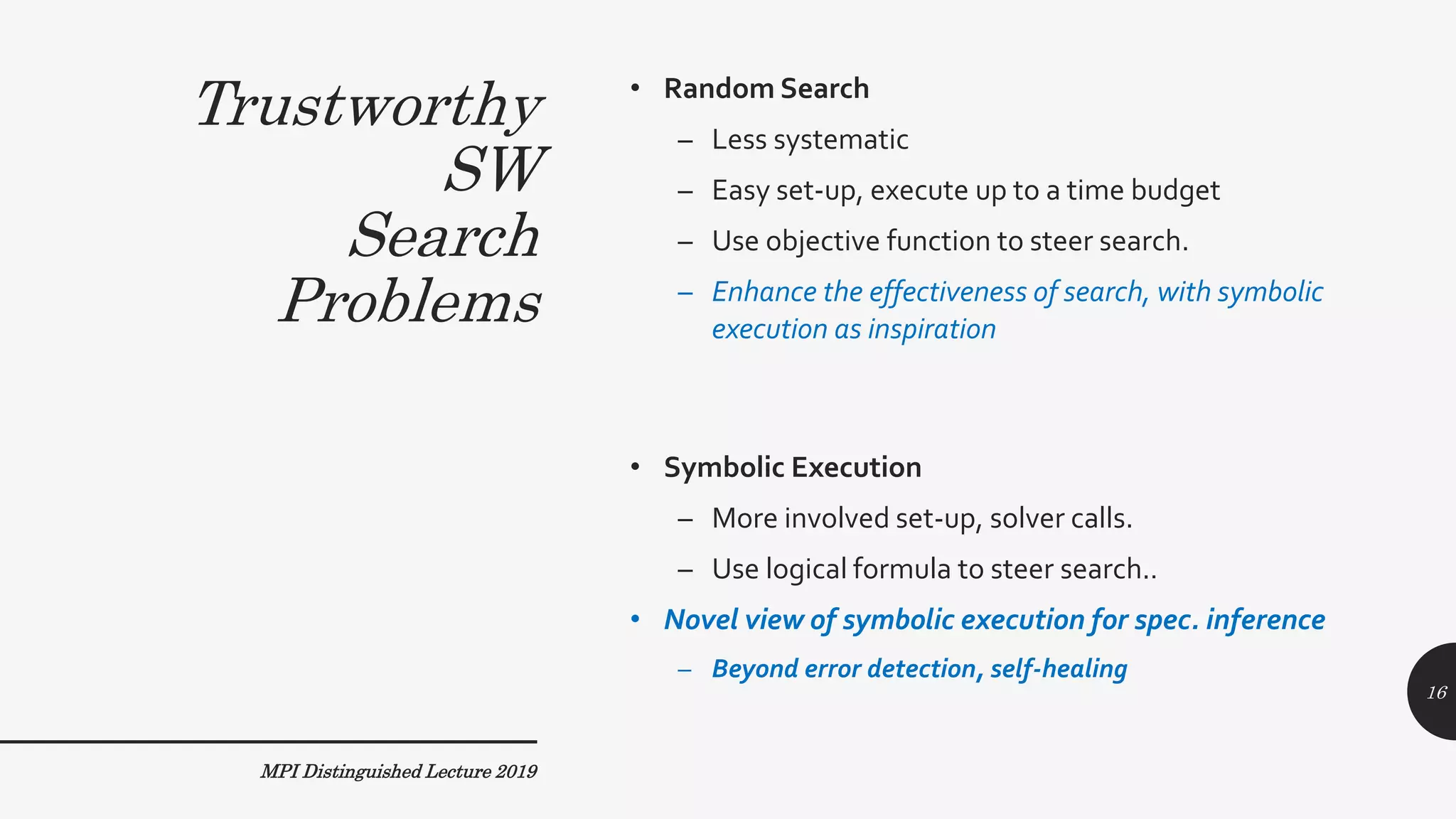
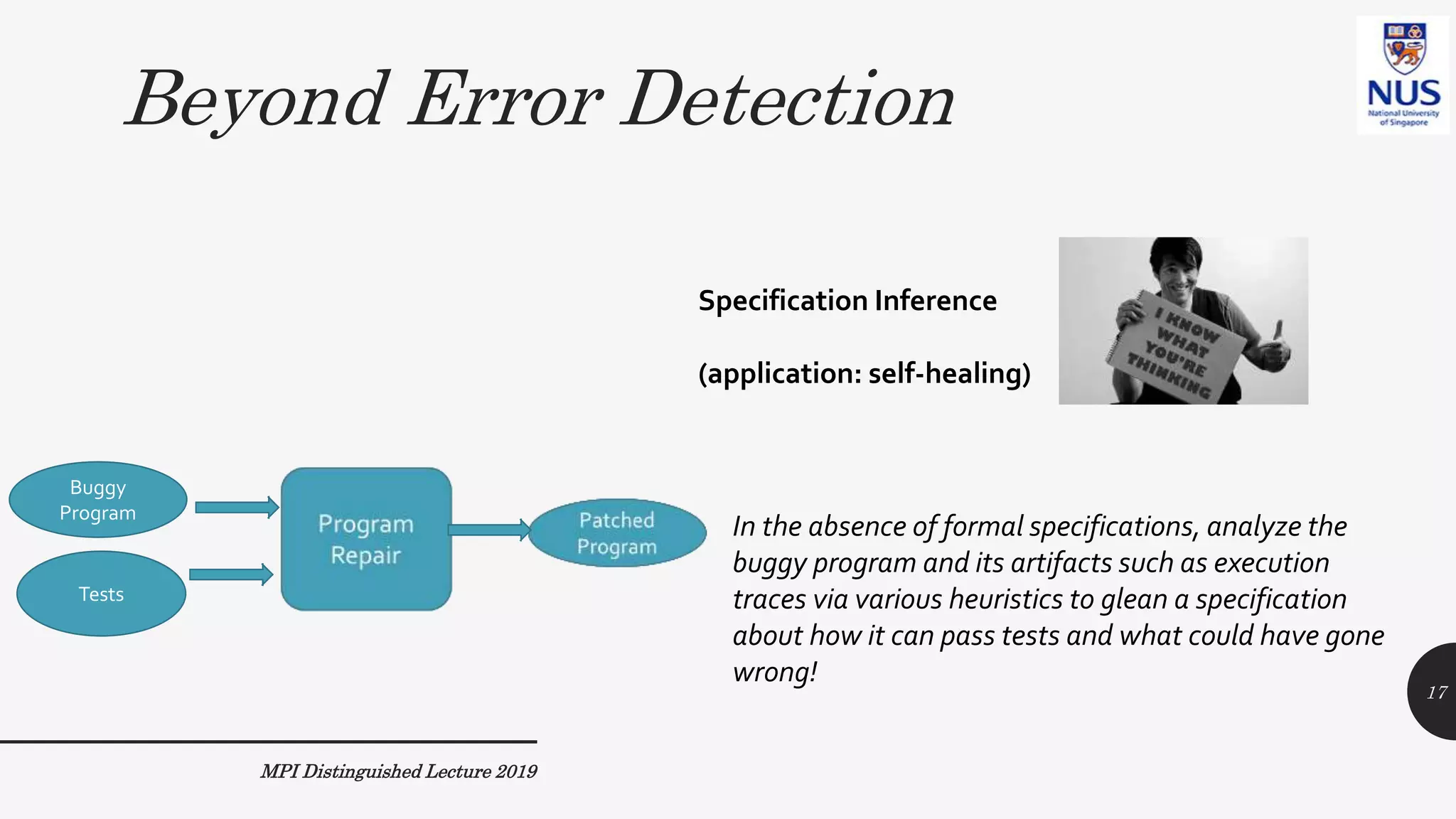
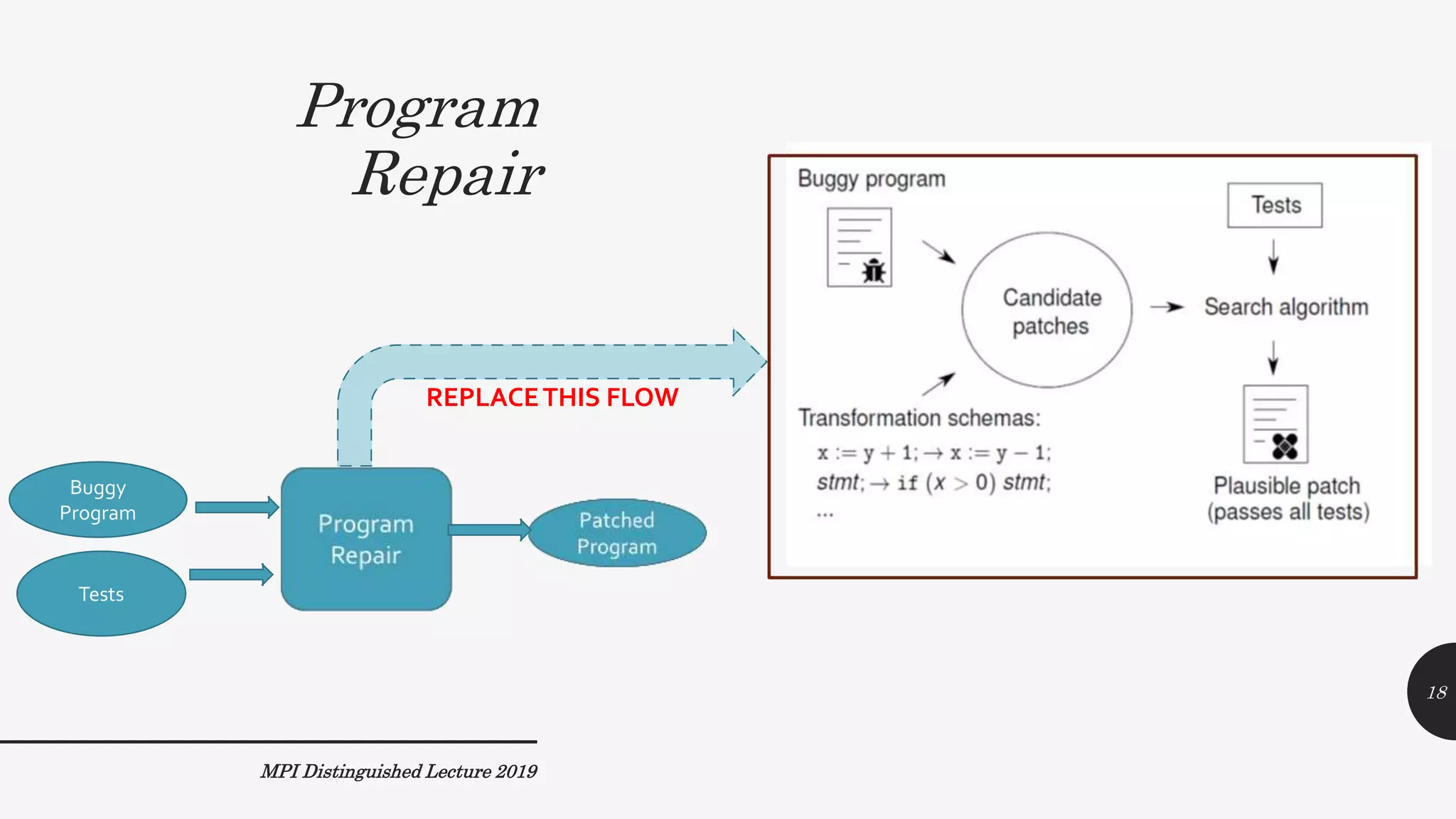
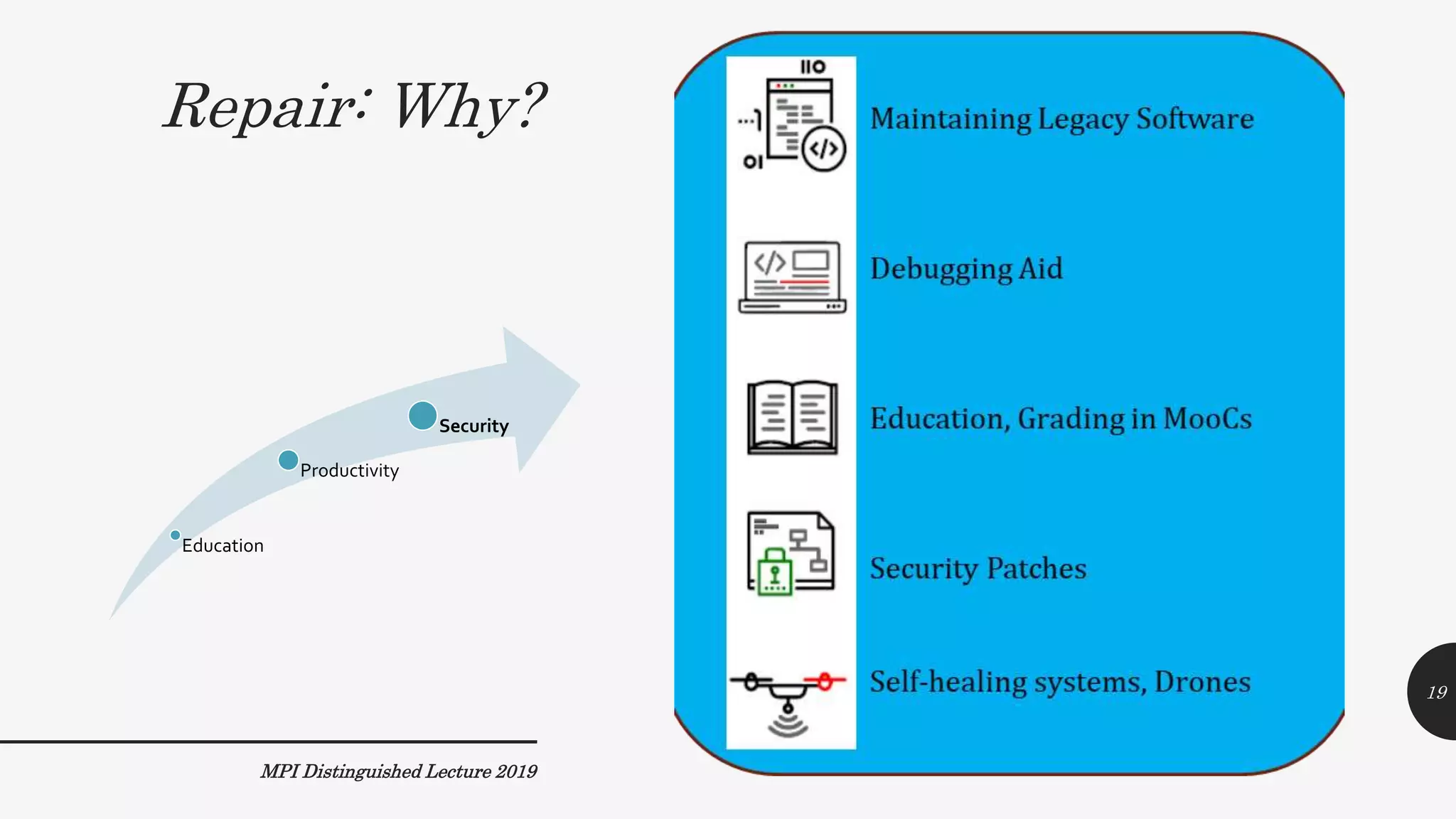
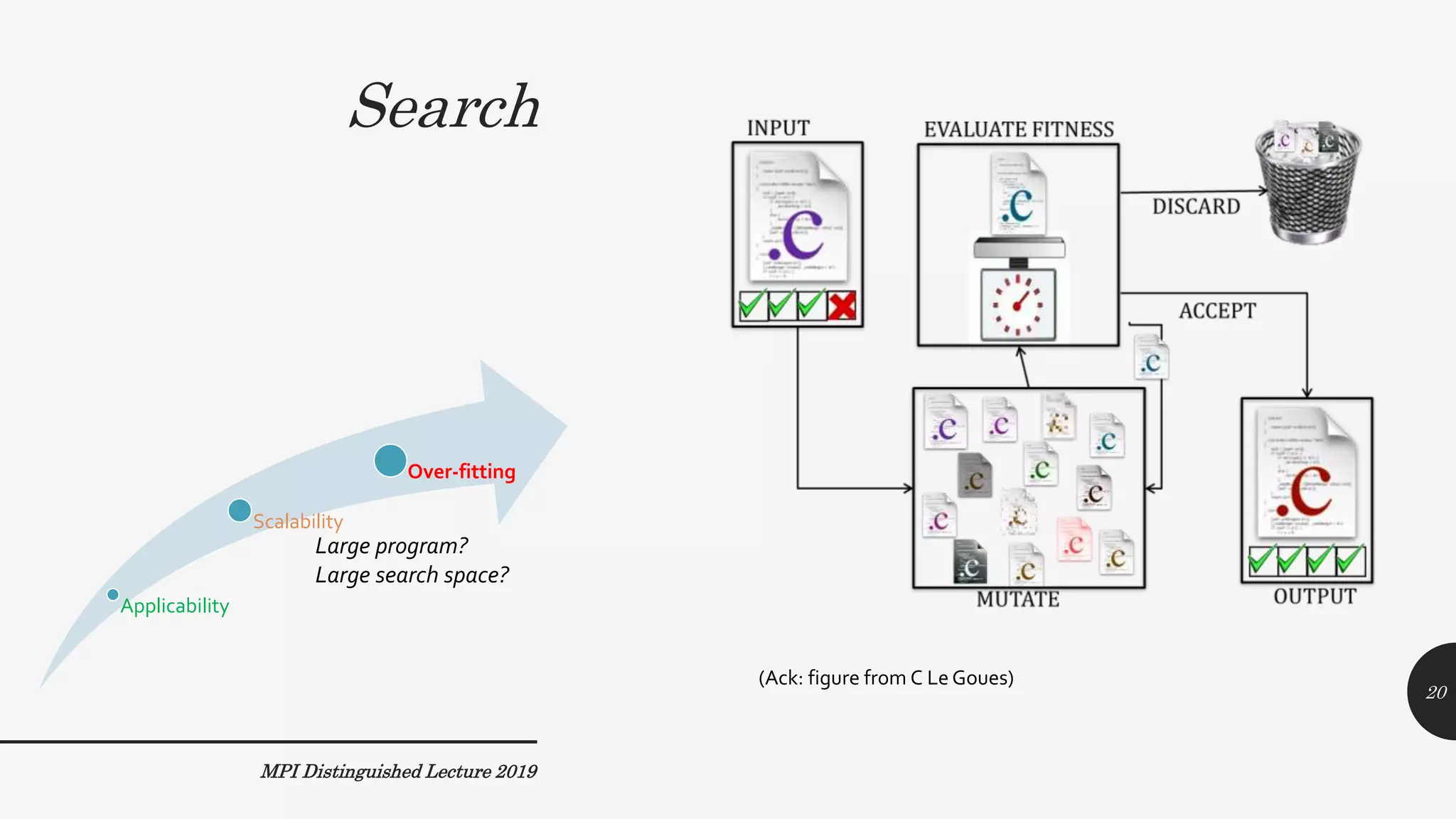
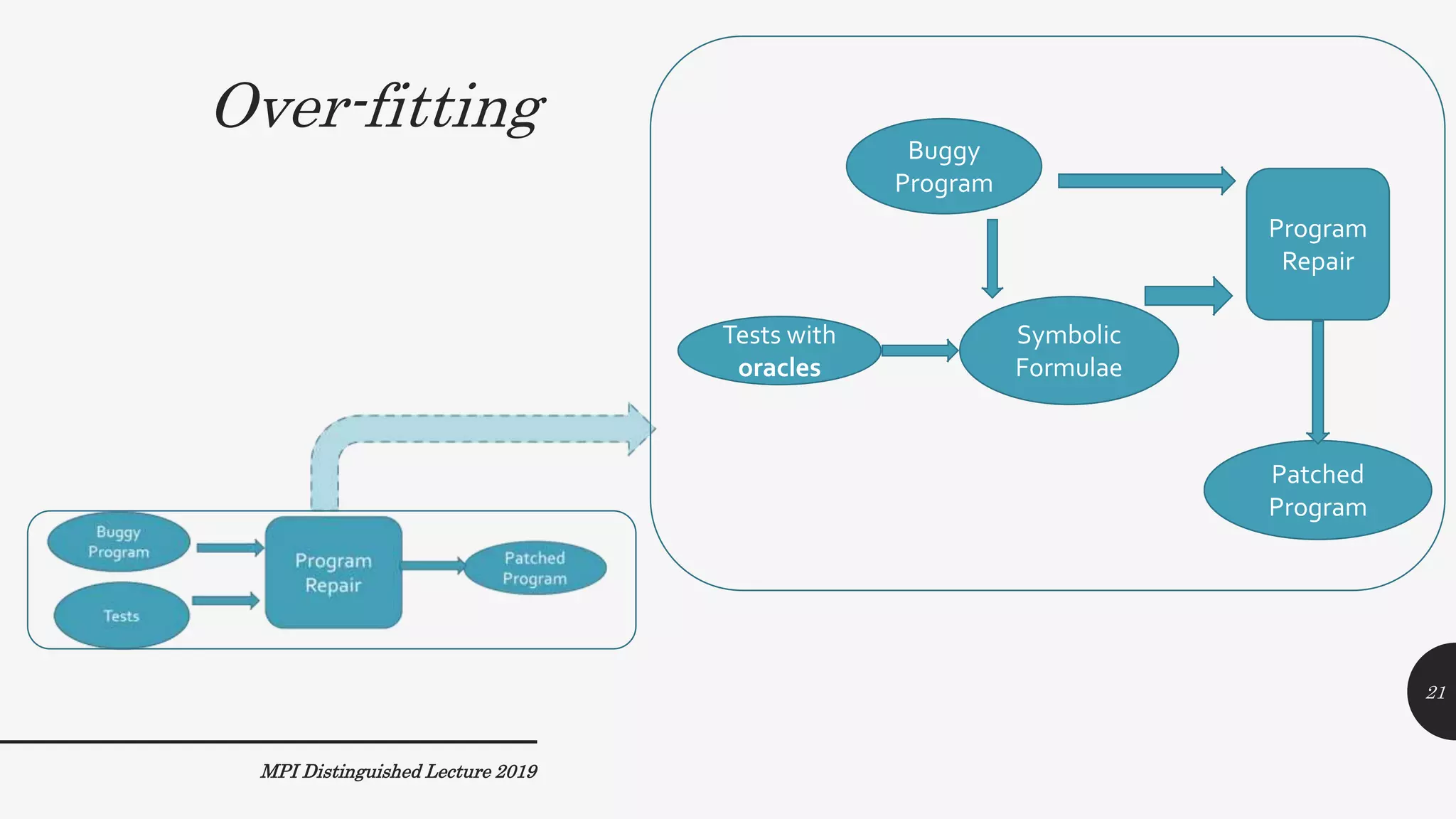

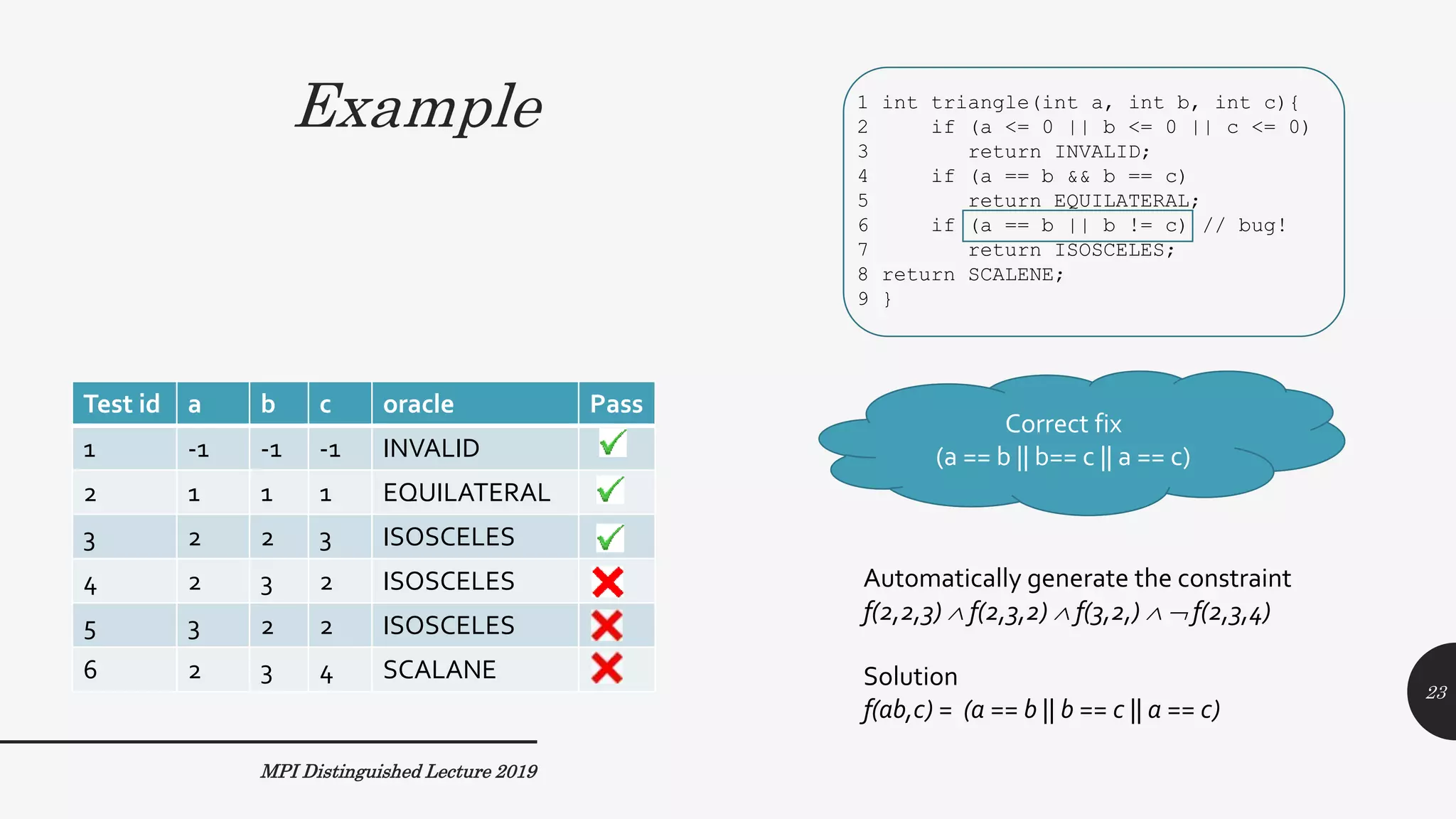
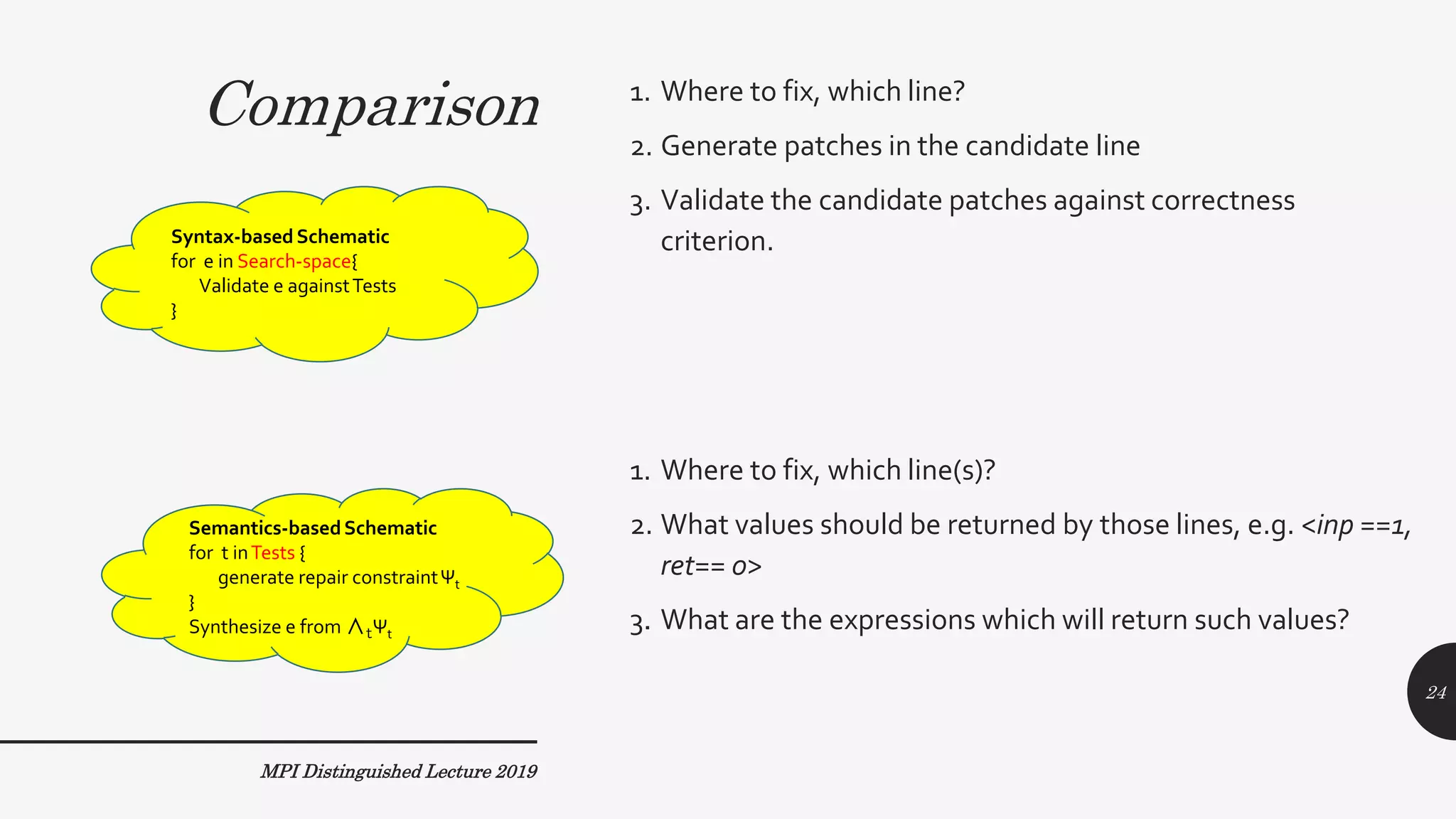
![Specification
Inference
MPI Distinguished Lecture 2019
var = f(live_vars) // X
Test input t
Concrete
values
Oracle (expected output)
Output:
Value-set or Constraint
Symbolic
execution
Program
Concrete Execution
[ICSE13] 25](https://image.slidesharecdn.com/mpi2019-190712015333/75/Automated-Program-Repair-Distinguished-lecture-at-MPI-SWS-25-2048.jpg)
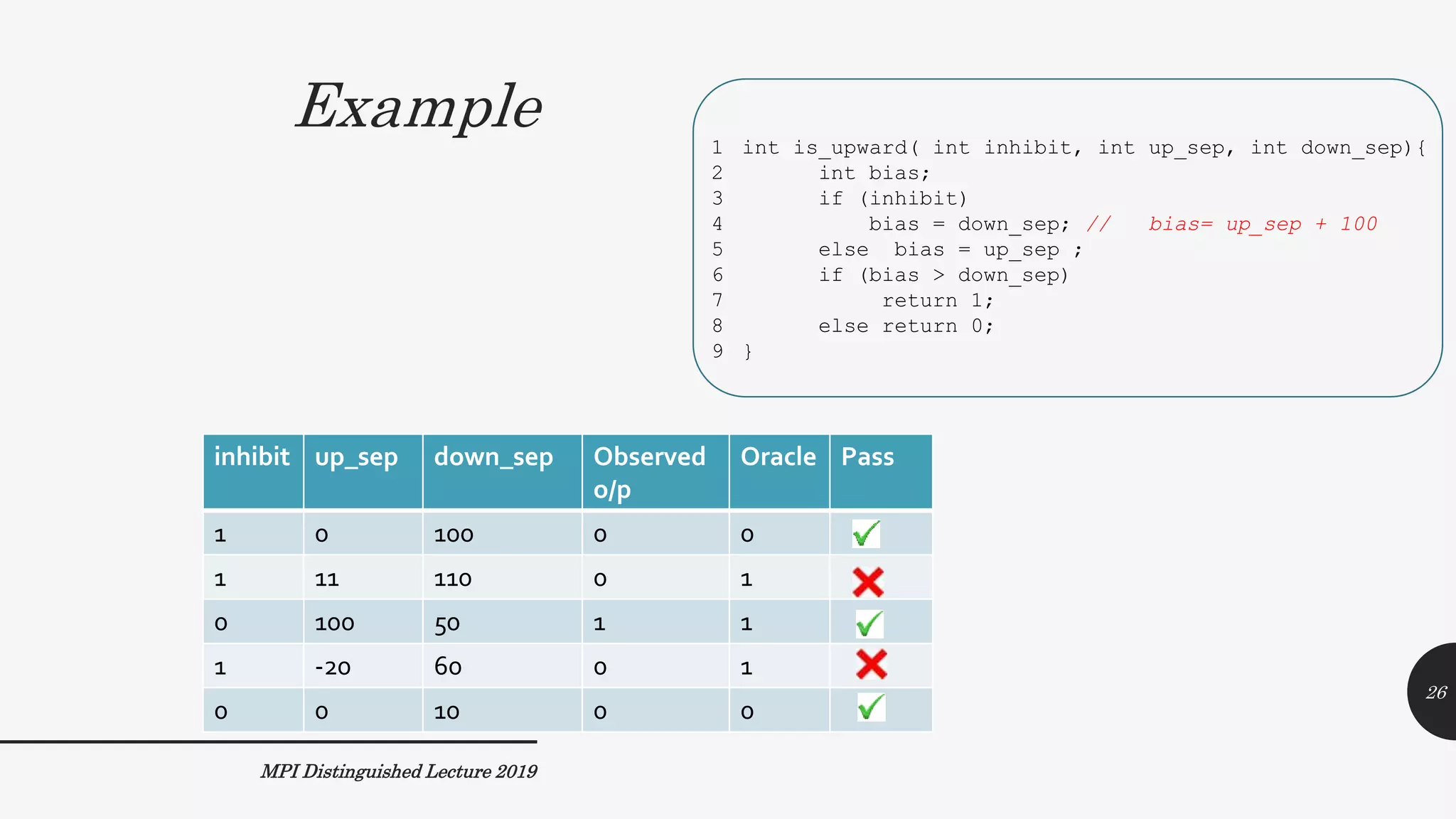
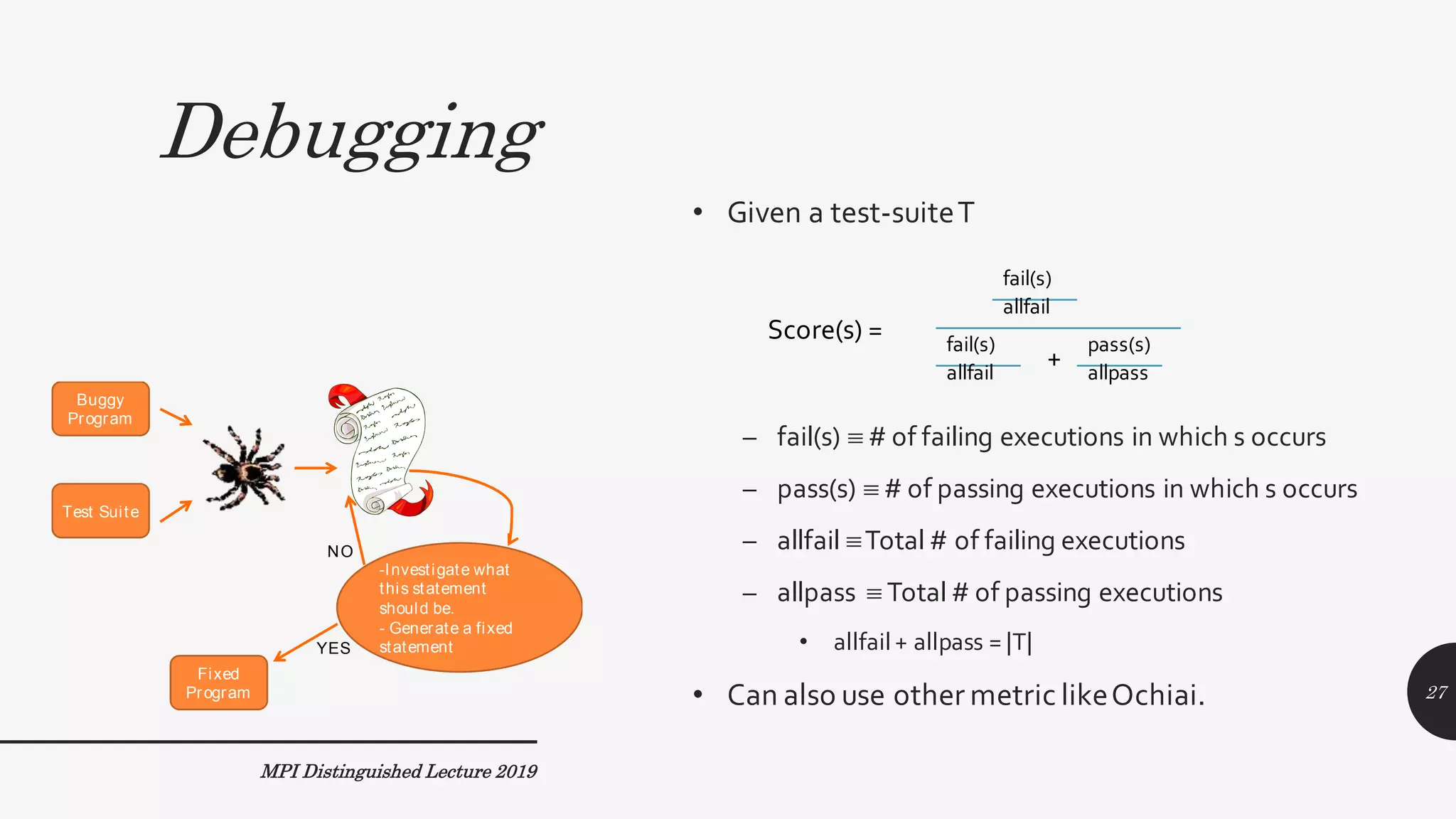
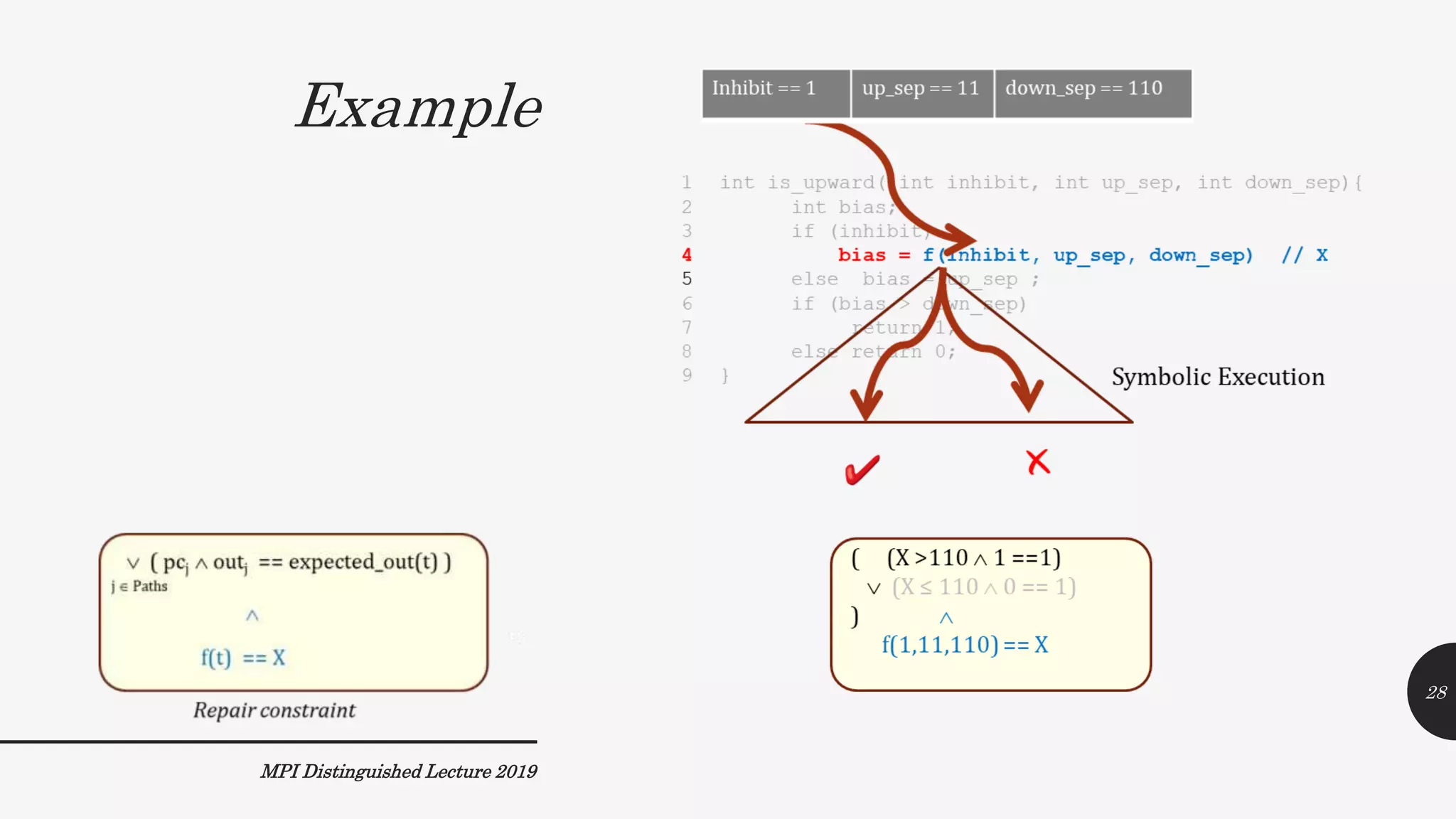
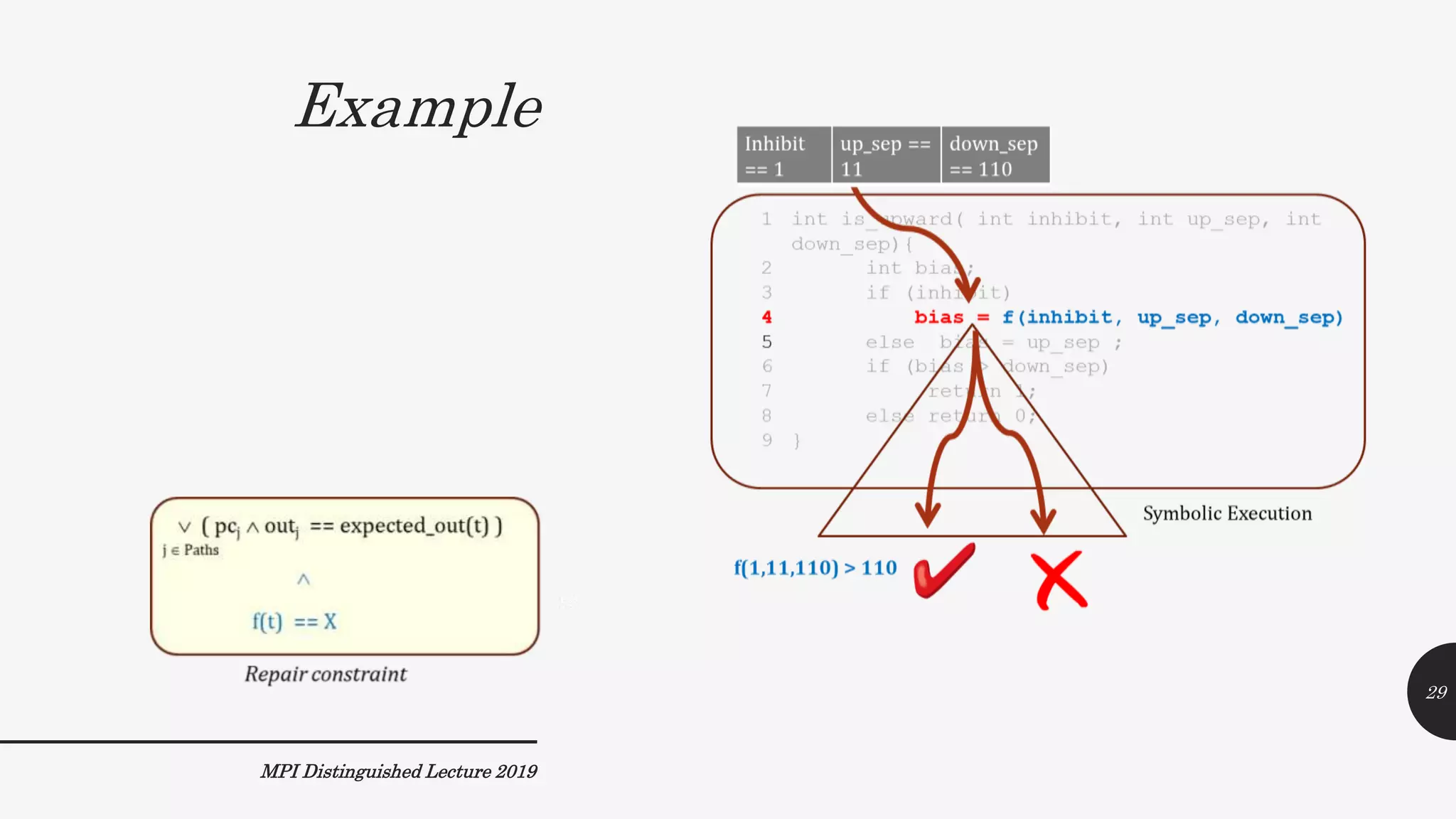
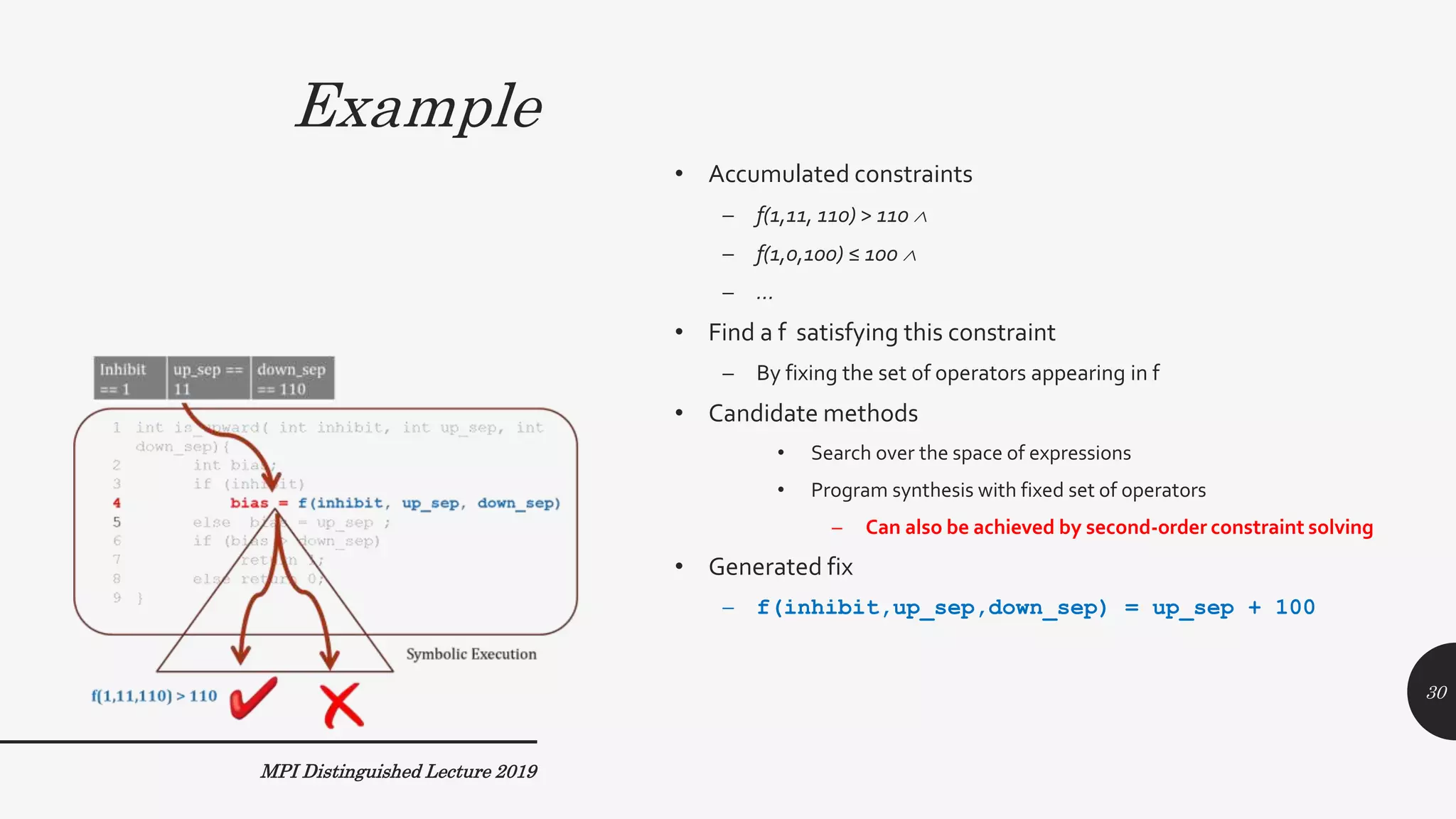
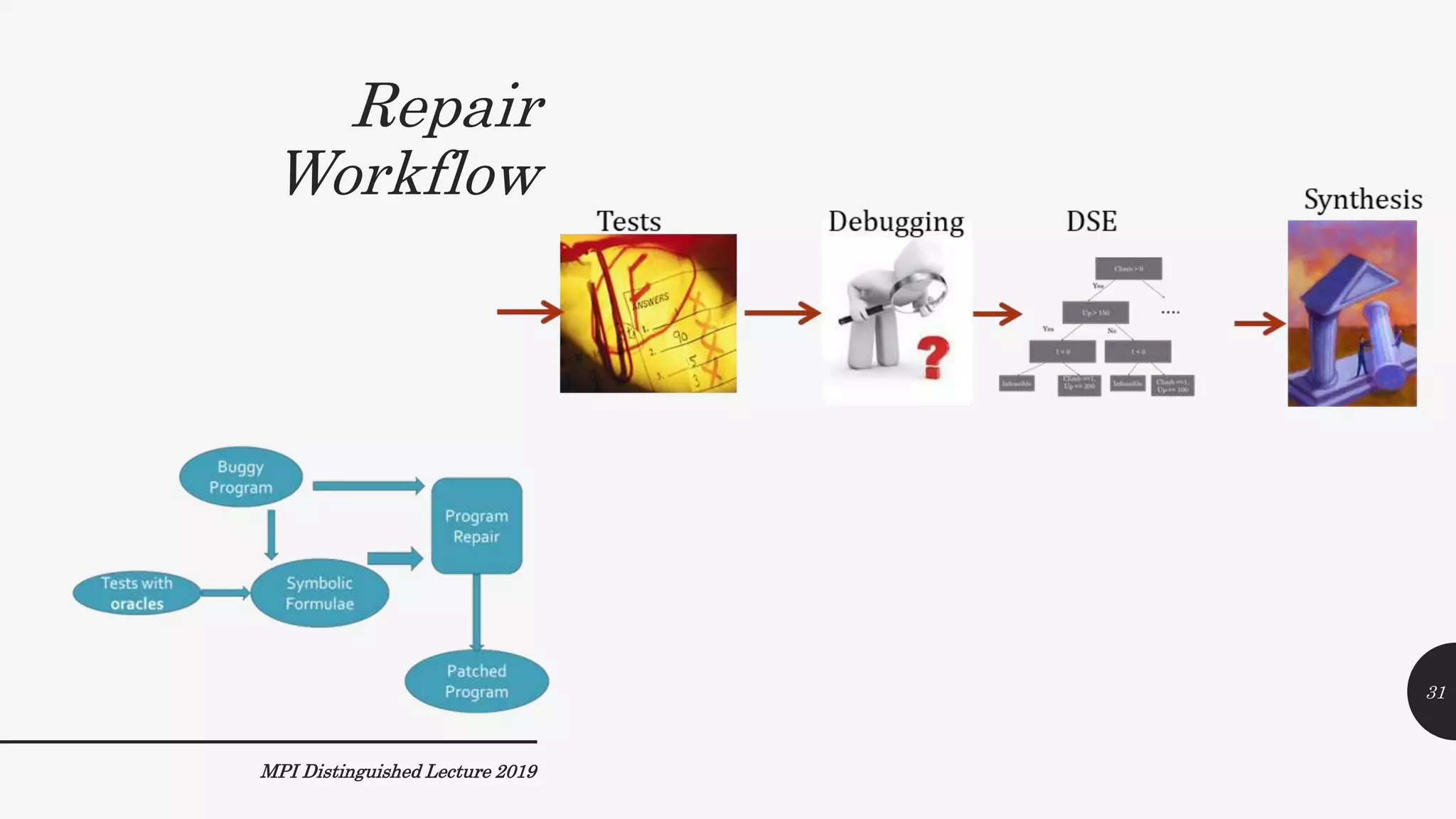
![Simplified
Workflow, but
MPI Distinguished Lecture 2019
Applicability
Over-fitting
Scalability
[ICSE15] 32](https://image.slidesharecdn.com/mpi2019-190712015333/75/Automated-Program-Repair-Distinguished-lecture-at-MPI-SWS-32-2048.jpg)
![Comparison
MPI Distinguished Lecture 2019
#Programs Equivalent Same Loc. Diff.
SemFix
[ICSE13]
44 17% 46% 6.36
DirectFix
[ICSE15]
44 53% 95% 2.31 33](https://image.slidesharecdn.com/mpi2019-190712015333/75/Automated-Program-Repair-Distinguished-lecture-at-MPI-SWS-33-2048.jpg)
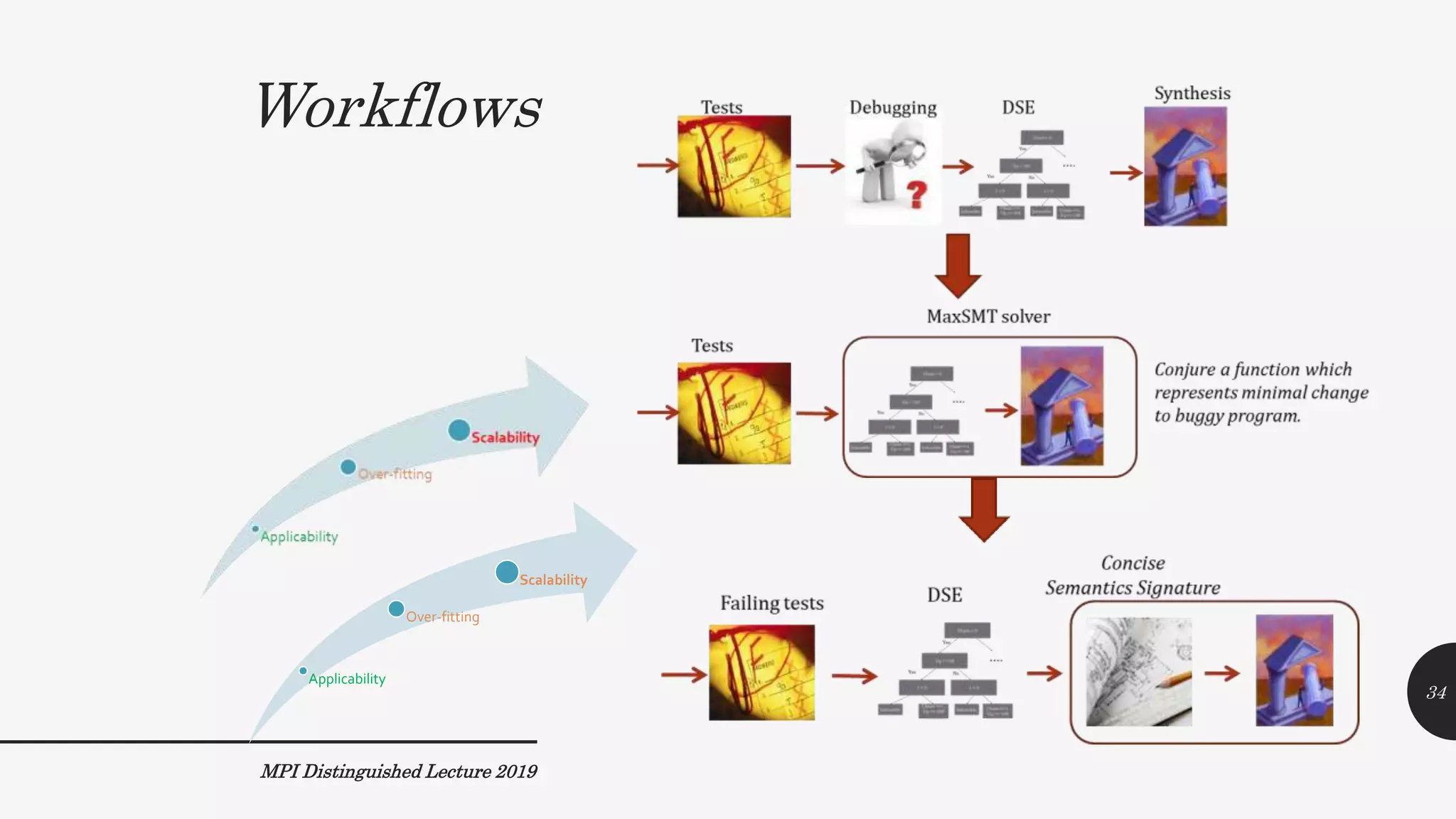
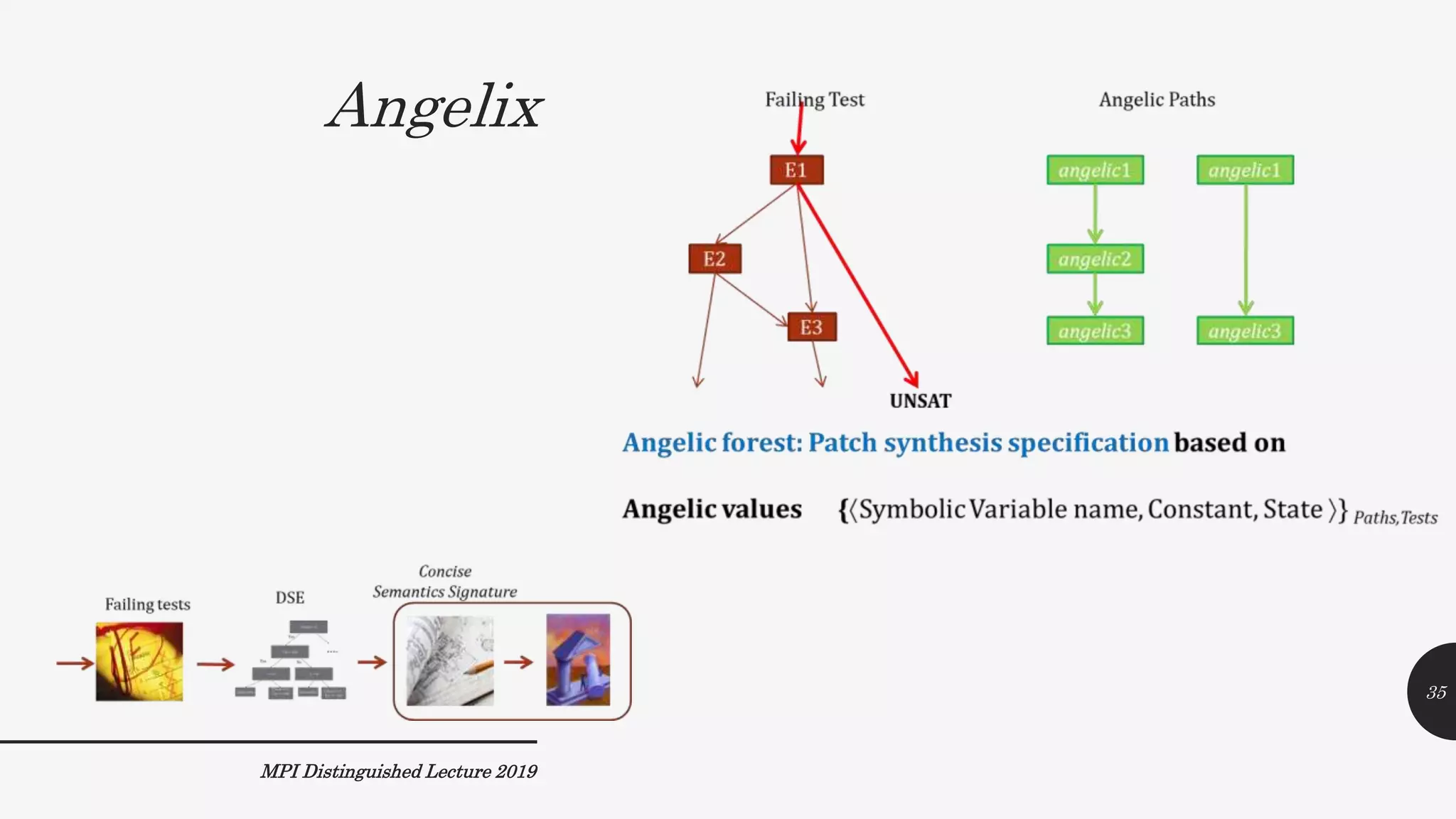
![Repair Constraint
MPI Distinguished Lecture 2019
• SemFix work (ICSE 2013)
– Example: for an identified expression e to be fixed
• [ X > 0 ] ∧ f(t) == X for each test t
• DirectFix work (ICSE 2015)
– Whole Program as repair constraint
– Use the principle of minimality to synthesize a minimal patch.
• Angelix work (ICSE 2016)
– Example: for identified expressions e1, e2, … to be fixed
– [ (X == 1) ∨ (X == 2) ∨ (X== 3)] ∧ f(t) ==X for each test t.
– [ (X== 1 ∧Y == 1) ∨ (X==2 ∧Y ==2)] ∧ f(t) ==X ∧g(t)==Y for each test t.
36](https://image.slidesharecdn.com/mpi2019-190712015333/75/Automated-Program-Repair-Distinguished-lecture-at-MPI-SWS-36-2048.jpg)
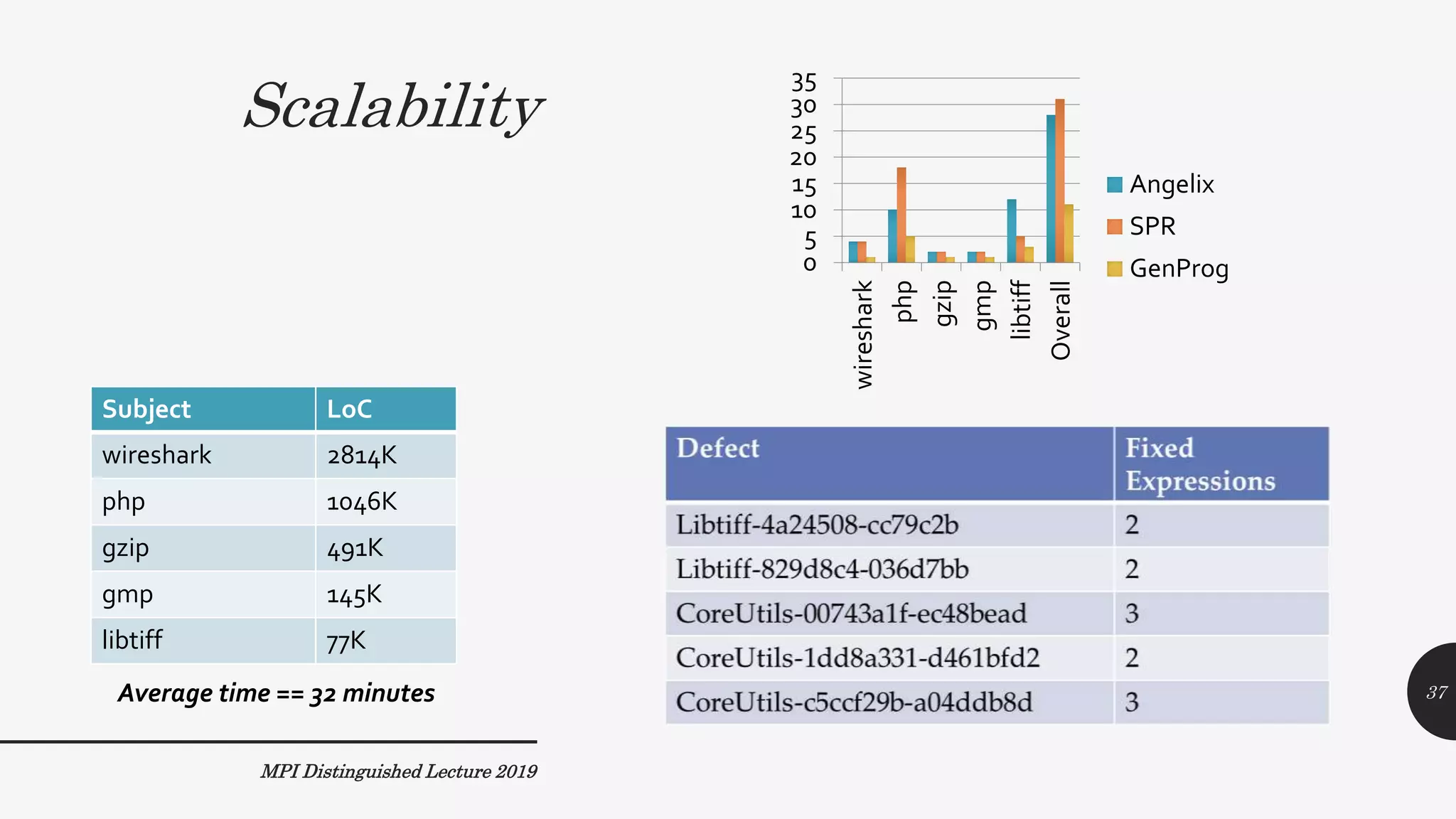
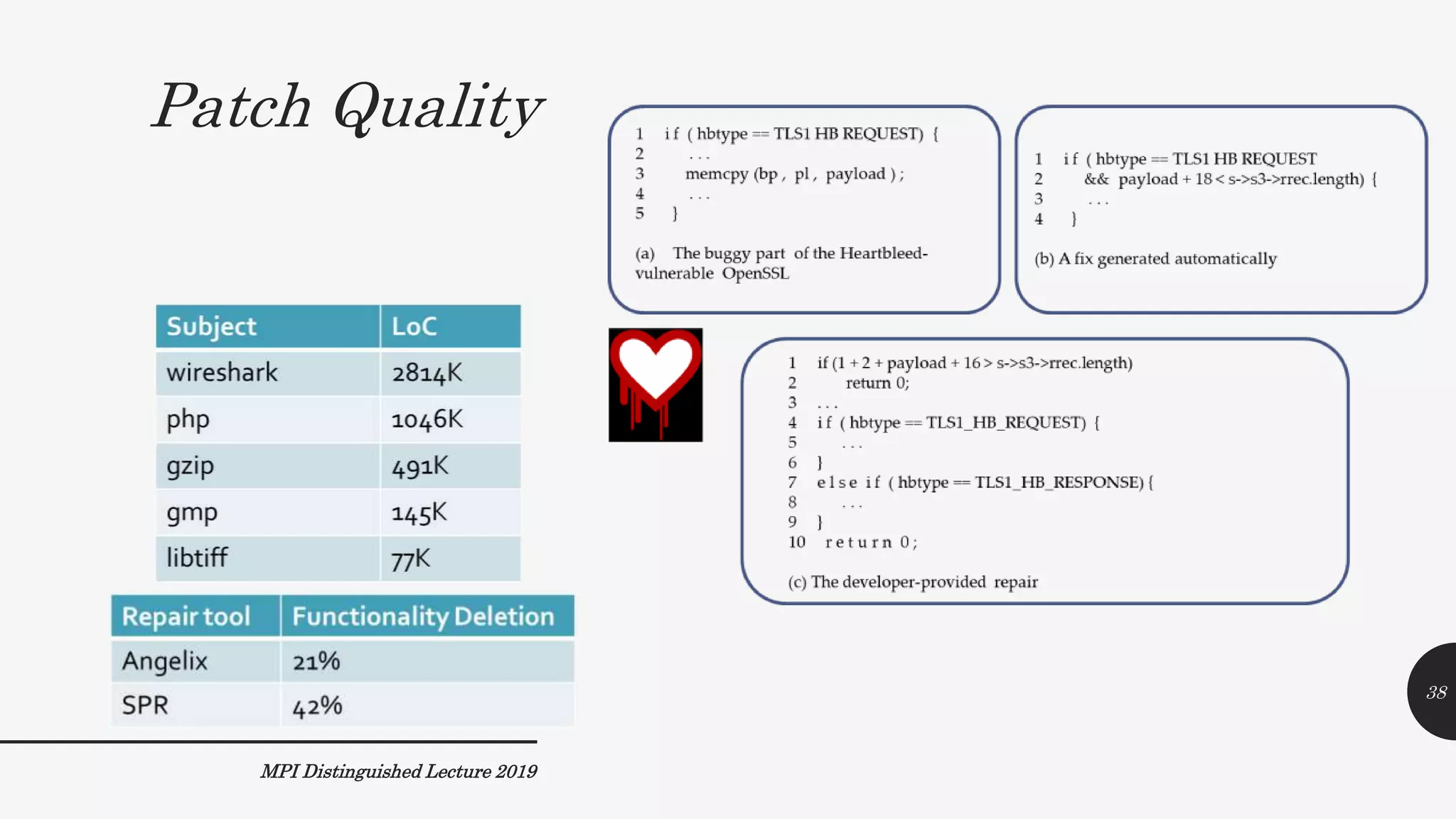
![Experience
of others
• “The core technique inAngelix using symbolic
execution and program synthesis works well”.
• “It can potentially suffer from poor fault localization”.
• “With better fault localization, the patch synthesis
seems hard to improve in effectiveness”
– Can still be improved in terms of efficiency
• [Anecdotal comments only from user groups]
MPI Distinguished Lecture 2019
[ICSE16 and its
usage]
39
Experience
of others](https://image.slidesharecdn.com/mpi2019-190712015333/75/Automated-Program-Repair-Distinguished-lecture-at-MPI-SWS-39-2048.jpg)
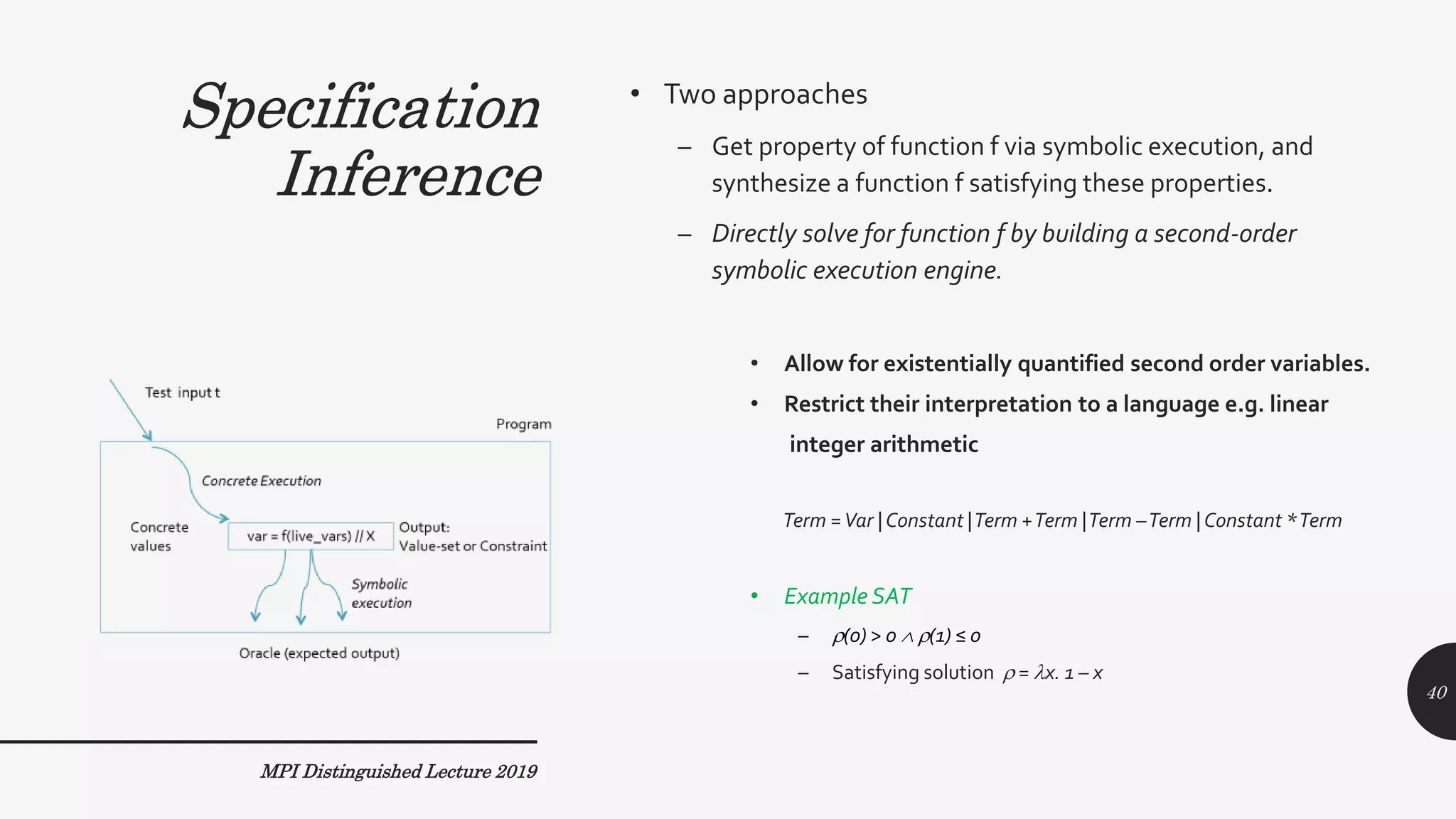
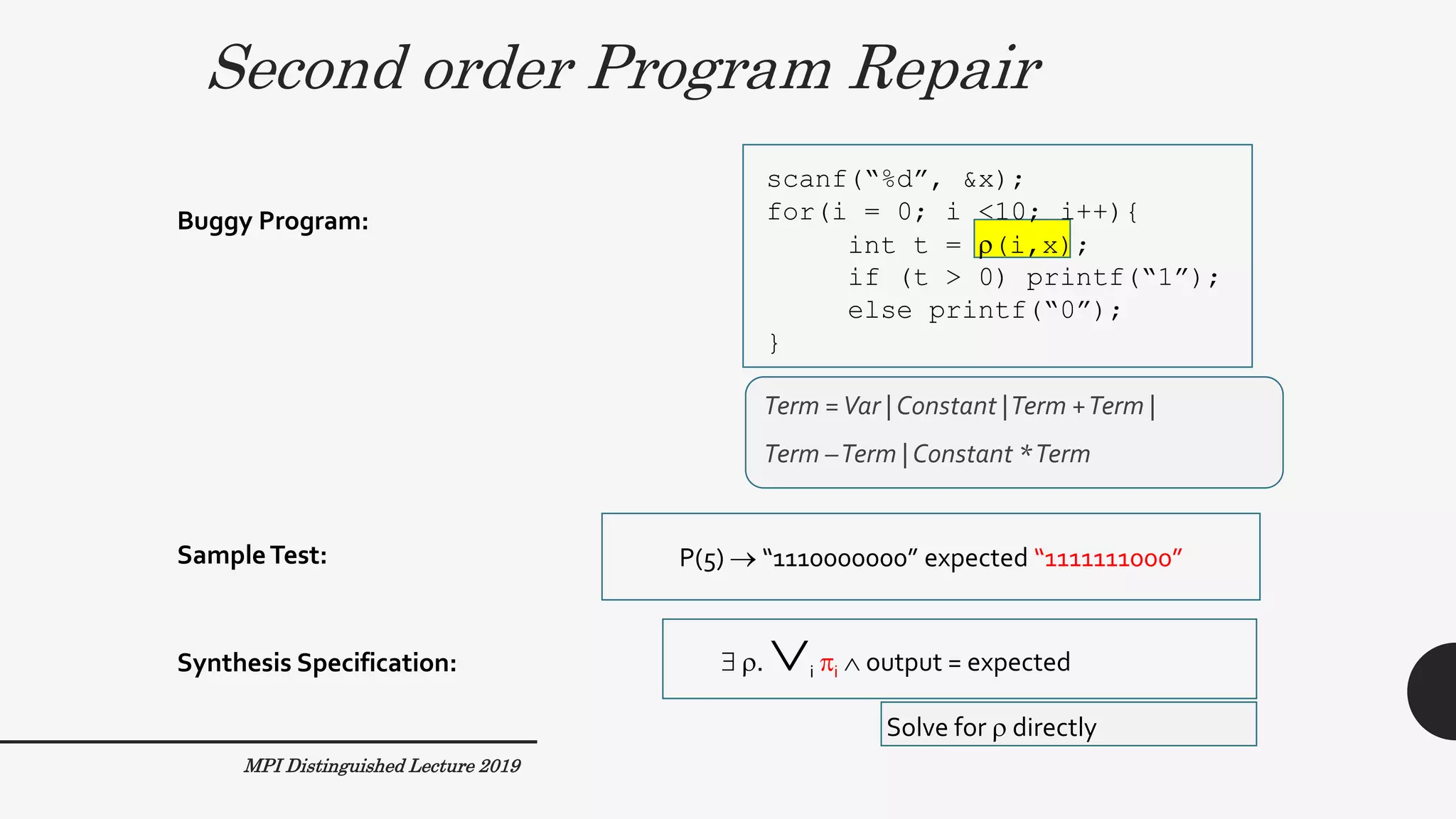
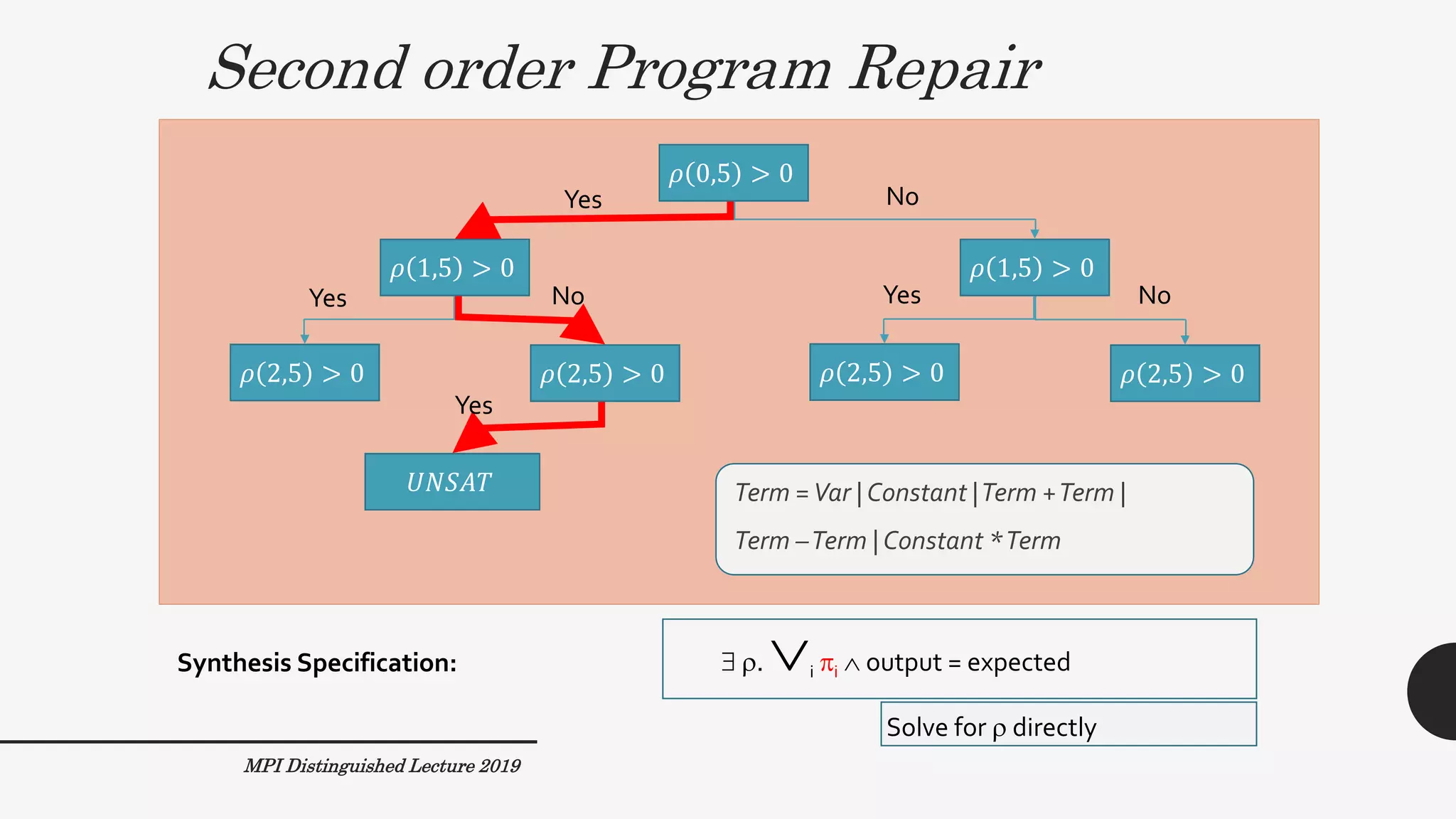
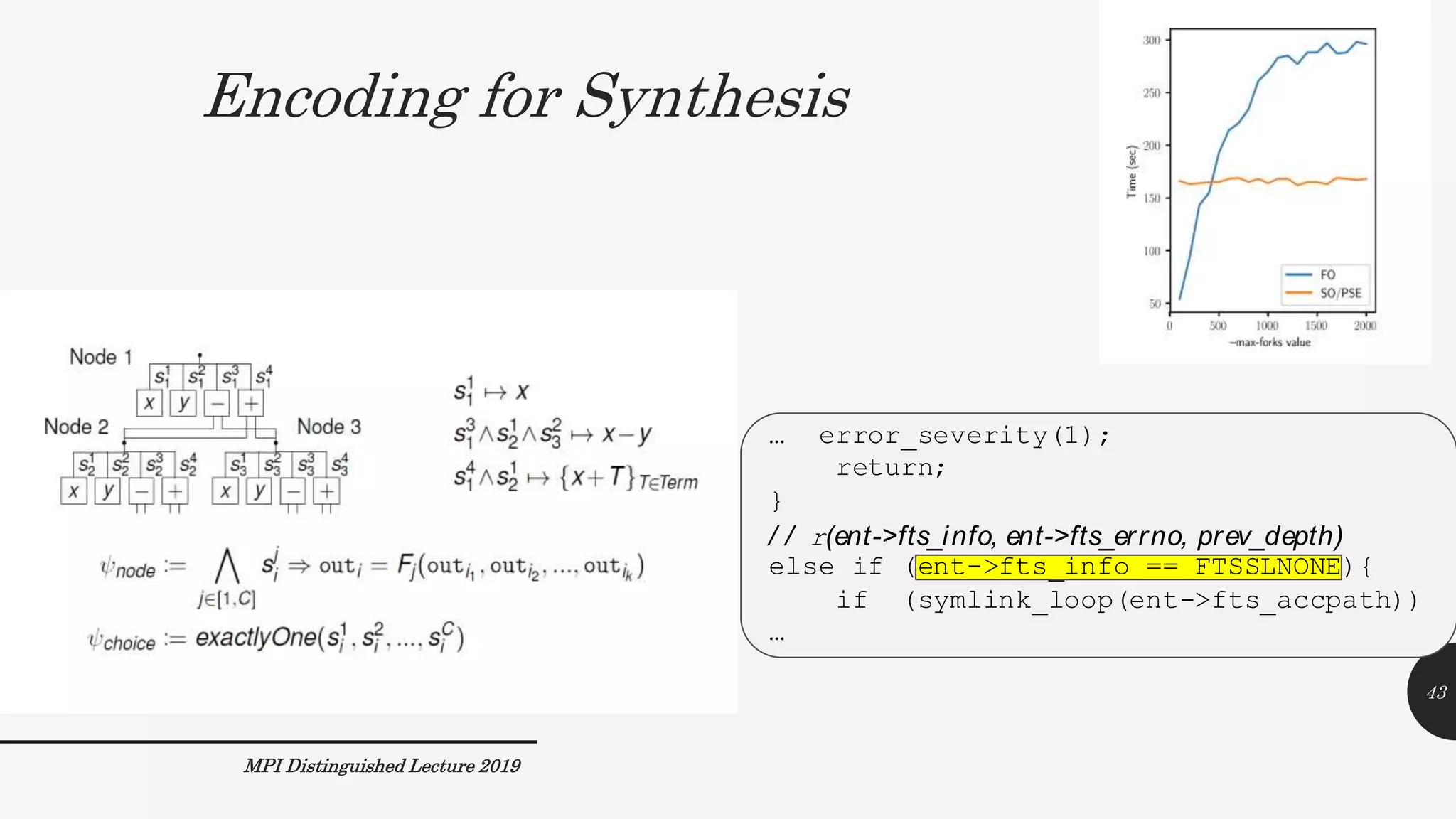
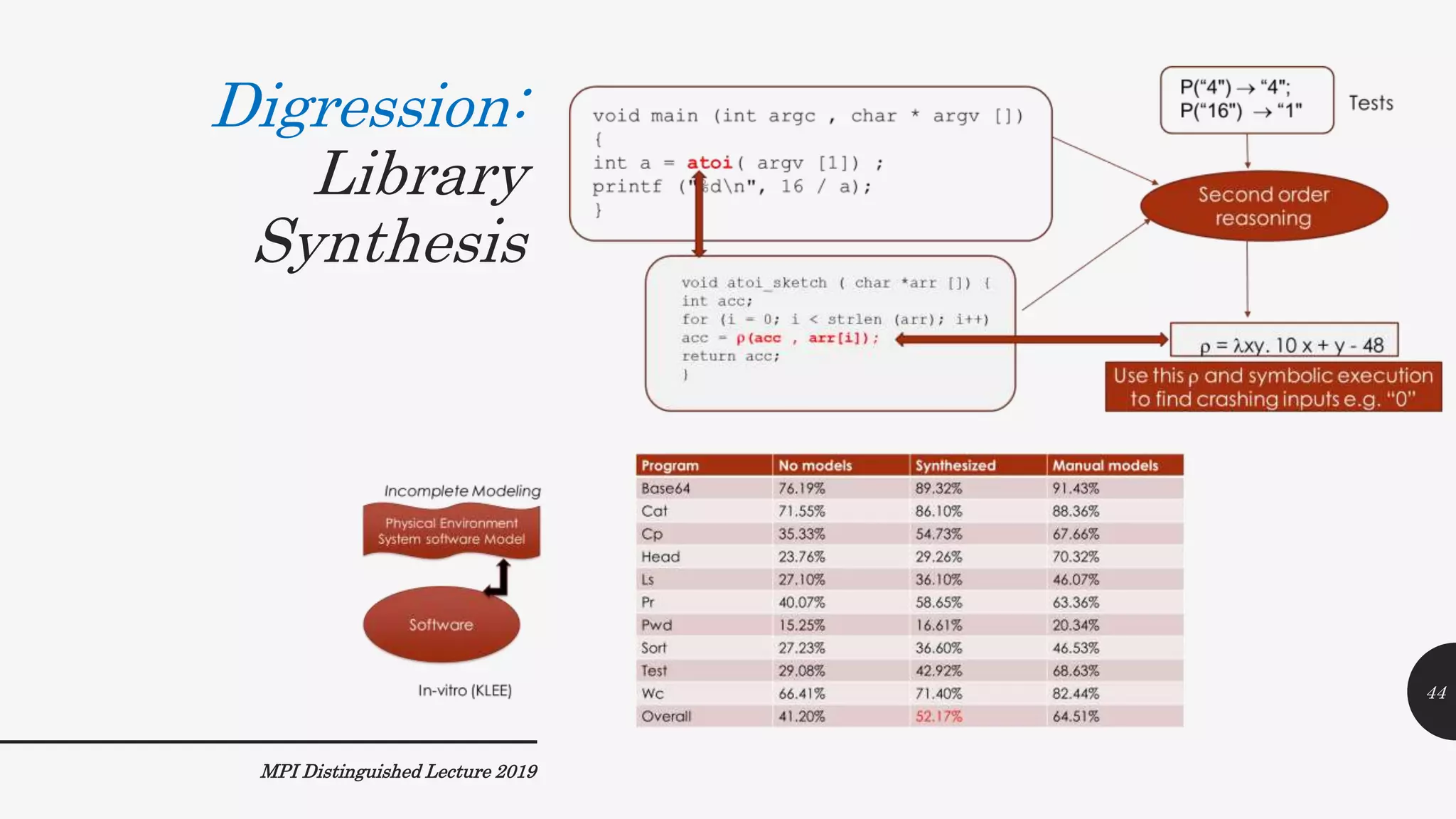
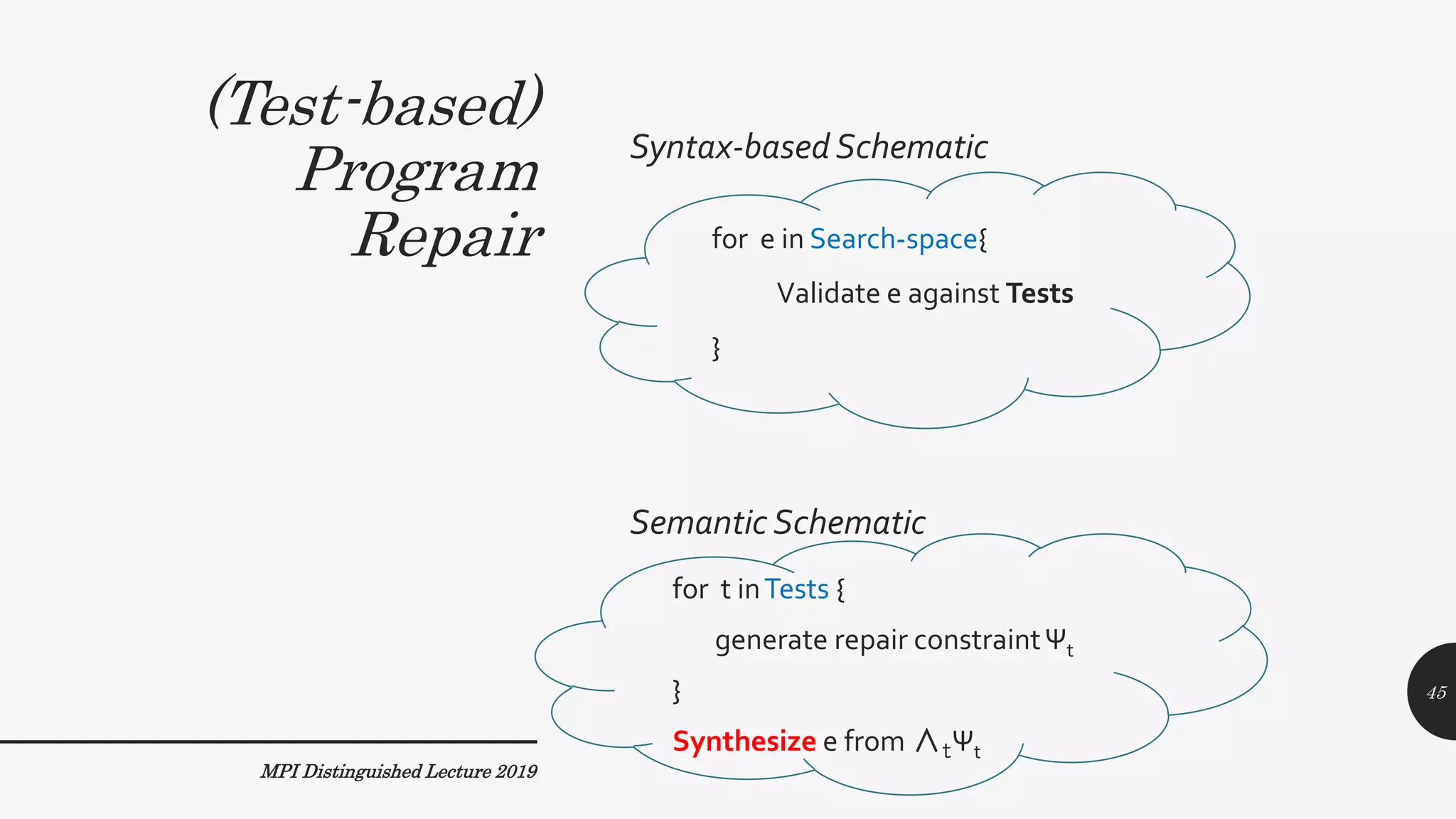
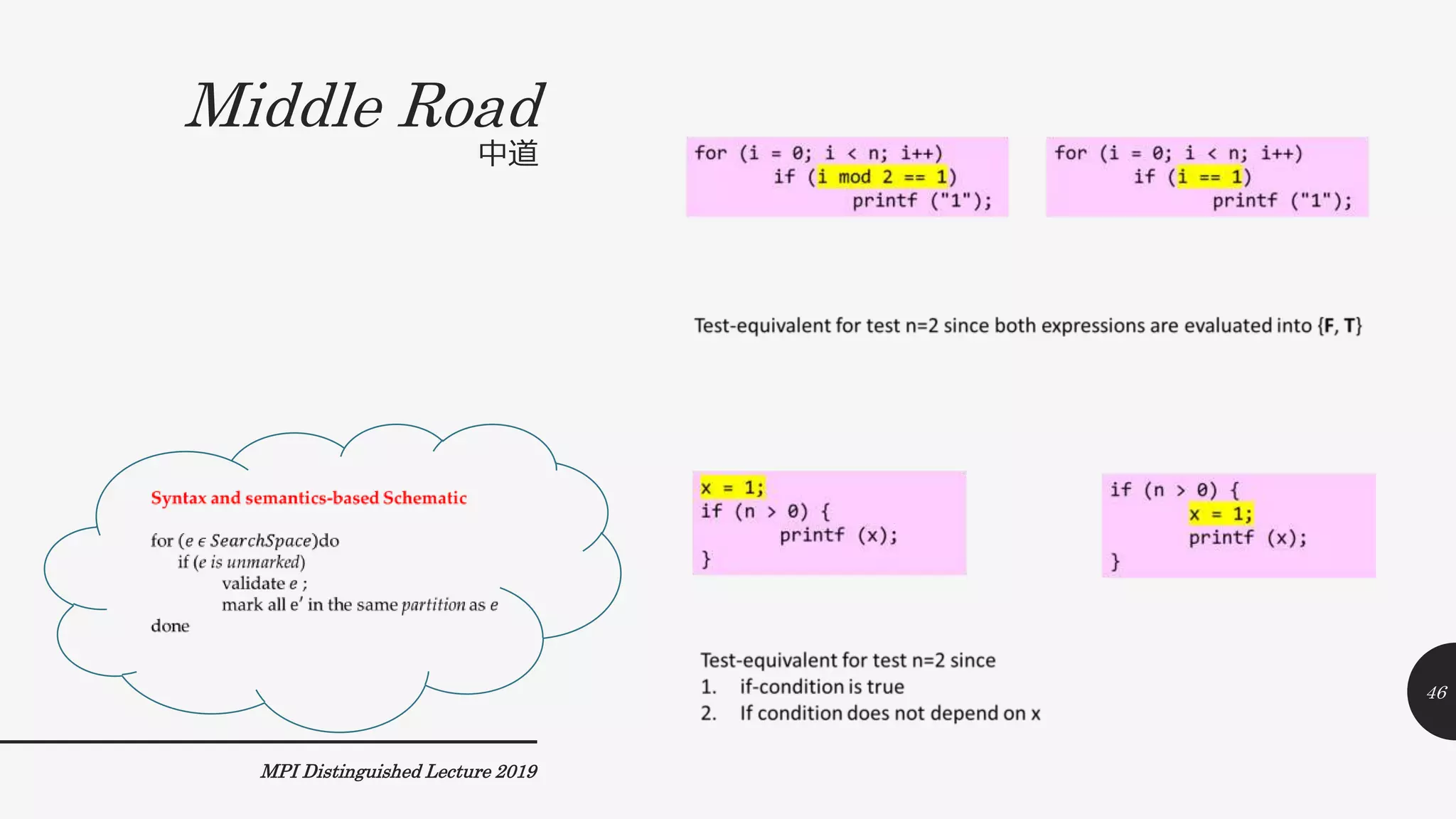
![Test-
equivalence
based repair
MPI Distinguished Lecture 2019
scanf ("%d" ,&x);
for (i = 0; i < 10; i++)
if (x – i > 0)
printf ("1");
else
printf ("0");
Consider all
inequalities
𝛼𝑥 ± 𝛽𝑖 [>≥=≠] 𝛾
Sequence of values: Equivalence class (x = 4):
{T, T, T, T, T, T, T, T, T, T} {x > 0, x > 1, …}
{T, T, T, T, T, T, T, T, T, F} {x – i > -5, …}
{T, T, T, T, T, T, T, T, F, T} EMPTY
{T, T, T, T, T, T, T, T, F, F} {x – i > -4, …}
{T, T, T, T, T, T, T, F, T, T} EMPTY
{T, T, T, T, T, T, T, F, T, F} EMPTY
{T, T, T, T, T, T, T, F, F,T} EMPTY
…
47](https://image.slidesharecdn.com/mpi2019-190712015333/75/Automated-Program-Repair-Distinguished-lecture-at-MPI-SWS-47-2048.jpg)
![Efficiency
MPI Distinguished Lecture 2019
48
[TOSEM18]](https://image.slidesharecdn.com/mpi2019-190712015333/75/Automated-Program-Repair-Distinguished-lecture-at-MPI-SWS-48-2048.jpg)
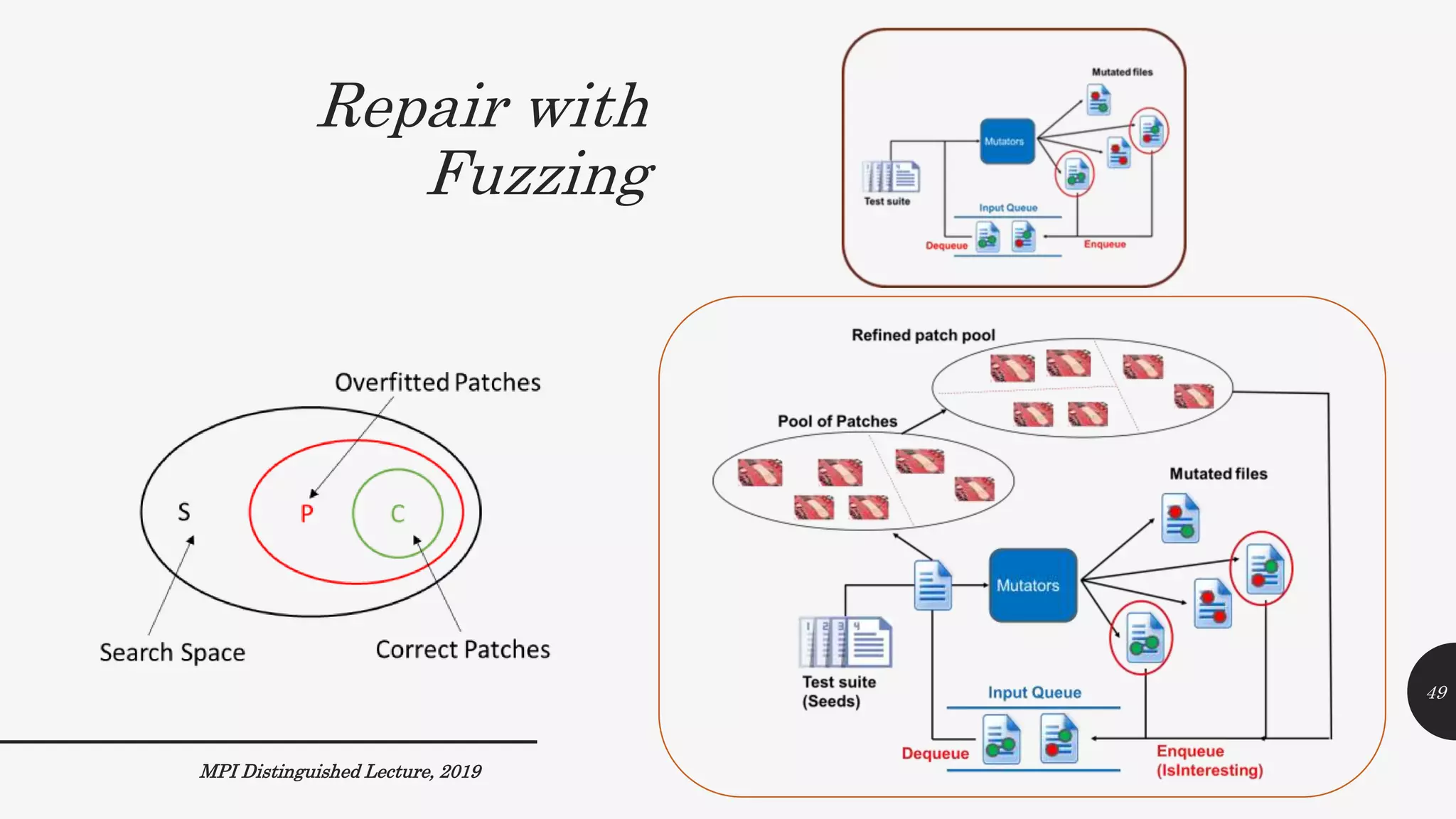
![Fix2Fit
MPI Distinguished Lecture 2019
50
Integration of repair into programming environments?
Number of plausible patches that can be reduced if the tests are
empowered with more oracles
[ISSTA19]](https://image.slidesharecdn.com/mpi2019-190712015333/75/Automated-Program-Repair-Distinguished-lecture-at-MPI-SWS-50-2048.jpg)
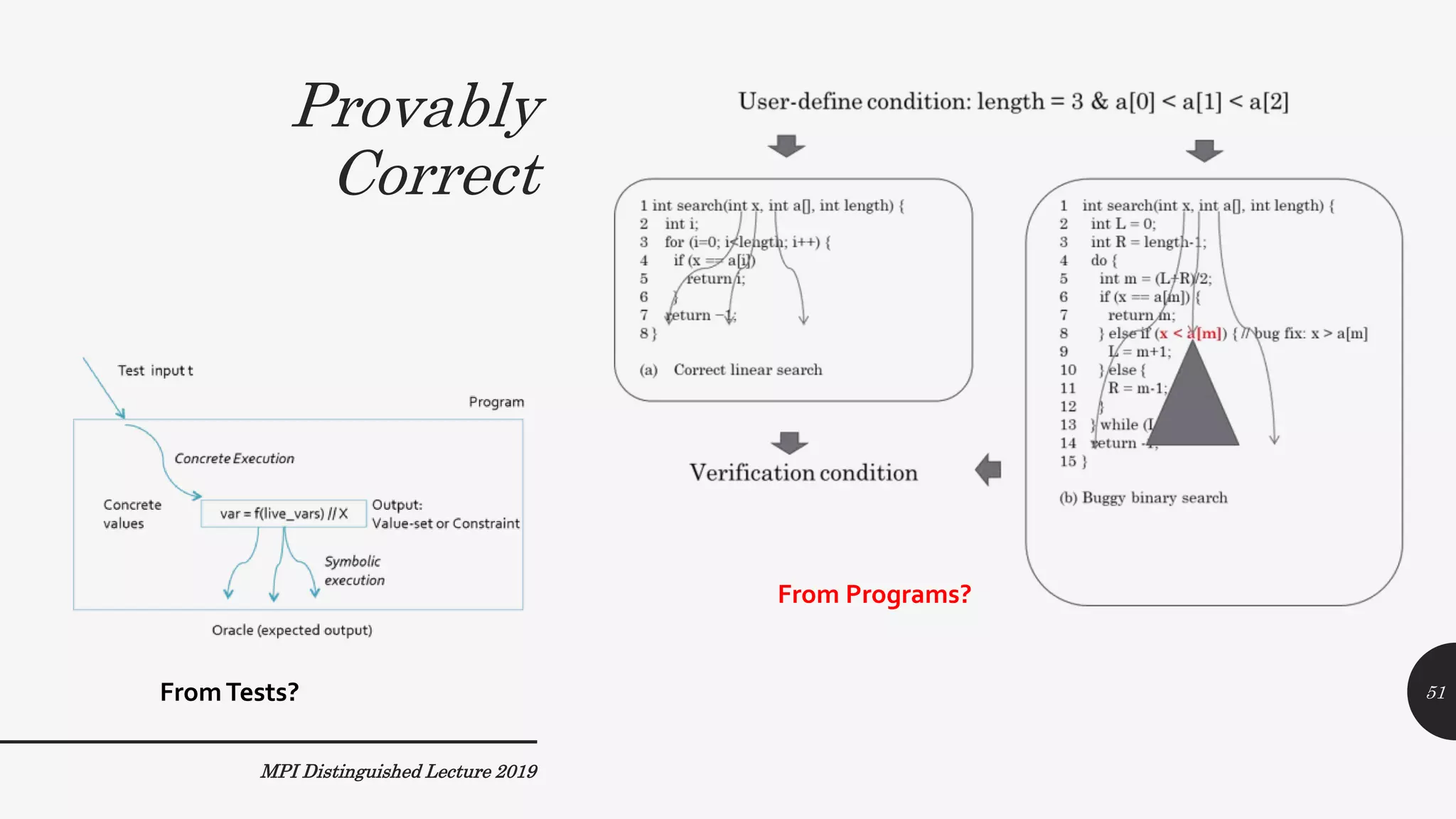
![Analyzing
Linux Busybox
MPI Distinguished Lecture 2019
52
[ICSE18]](https://image.slidesharecdn.com/mpi2019-190712015333/75/Automated-Program-Repair-Distinguished-lecture-at-MPI-SWS-52-2048.jpg)
![Other
Applications:
Education
MPI Distinguished Lecture 2019
Education
Productivity
Security
Intelligent tutoring systems:Automated grading and
hint generation via Program Repair
Detailed Study in IIT-Kanpur, India [FSE17, and ongoing] 53](https://image.slidesharecdn.com/mpi2019-190712015333/75/Automated-Program-Repair-Distinguished-lecture-at-MPI-SWS-53-2048.jpg)
